Gels/Hydrogels in Different Devices/Instruments—A Review
Abstract
1. Introduction
2. Gels/Hydrogels
2.1. Properties of Gels/Hydrogels
2.2. Fabrication and Structure of Gels/Hydrogels
2.3. Application of Gels/Hydrogels
2.4. Choice Preparation Method of Gel/Hydrogel for Devices
3. Gels in Devices
3.1. Gels in a Sensor
3.2. Hydrogels in Actuators
3.3. Hydrogels in Touch Panels
3.4. Hydrogels in Solar Cells
3.5. Hydrogels in Flexible Energy Storage and Batteries
3.6. Hydrogels in Soft Robotics
3.7. Gels in Thermal Insulators
4. Conclusions
Author Contributions
Funding
Data Availability Statement
Acknowledgments
Conflicts of Interest
References
- Rogovina, L.Z.; Vasil’ev, V.G.; Braudo, E.E. Definition of the Concept of Polymer Gel. Polym. Sci.-Ser. C 2008, 50, 85–92. [Google Scholar] [CrossRef]
- Almdal, K.; Dyre, J.; Hvidt, S.; Kramer, O. Towards a Phenomenological Definition of the Term ‘Gel’. Polym. Gels Netw. 1993, 1, 5–17. [Google Scholar] [CrossRef]
- Malpure, P.S.; Patil, S.S.; More, Y.M.; Nikam, P.P. A Review On-Hydrogel. Am. J. PharmTech Res. 2018, 8, 42–60. [Google Scholar] [CrossRef]
- He, G.; Ke, W.; Chen, X.; Kong, Y.; Zheng, H.; Yin, Y.; Cai, W. Preparation and Properties of Quaternary Ammonium Chitosan-g-Poly(Acrylic Acid-co-Acrylamide) Superabsorbent Hydrogels. React. Funct. Polym. 2017, 111, 14–21. [Google Scholar] [CrossRef]
- Ganesamoorthy, R.; Vadivel, V.K.; Kumar, R.; Kushwaha, O.S.; Mamane, H. Aerogels for Water Treatment: A Review. J. Clean. Prod. 2021, 329, 129713. [Google Scholar] [CrossRef]
- Filipcsei, G.; Fehér, J.; Zrínyi, M. Electric Field Sensitive Neutral Polymer Gels. J. Mol. Struct. 2000, 554, 109–117. [Google Scholar] [CrossRef]
- Haque, S.N.; Bhuyan, M.M.; Jeong, J. Radiation-Induced Hydrogel for Water Treatment. Gels 2024, 10, 375. [Google Scholar] [CrossRef]
- Liang, N.; Wu, L.; Yang, Y. Multifunctional Double Network Hydrogel Film for Skin Wound Healing. Mater. Express 2021, 11, 1084–1091. [Google Scholar] [CrossRef]
- Kloxin, A.M.; Kasko, A.M.; Salinas, C.N.; Anseth, K.S. Photodegradable Hydrogels for Dynamic Tuning of Physical and Chemical Properties. Science 2009, 324, 59–63. [Google Scholar] [CrossRef]
- Wu, S.; Hua, M.; Alsaid, Y.; Du, Y.; Ma, Y.; Zhao, Y.; Lo, C.Y.; Wang, C.; Wu, D.; Yao, B.; et al. Poly(Vinyl Alcohol) Hydrogels with Broad-Range Tunable Mechanical Properties via the Hofmeister Effect. Adv. Mater. 2021, 33, 2007829. [Google Scholar] [CrossRef]
- Hou, Y.; Li, Y.; Li, Y.; Li, D.; Guo, T.; Deng, X.; Zhang, H.; Xie, C.; Lu, X. Tuning Water-Resistant Networks in Mussel-Inspired Hydrogels for Robust Wet Tissue and Bioelectronic Adhesion. ACS Nano 2023, 17, 2745–2760. [Google Scholar] [CrossRef]
- Gao, N.; Pan, C. Intelligent Ion Gels: Design, Performance, and Applications. SmartMat 2024, 5, e1215. [Google Scholar] [CrossRef]
- Peñas-Núñez, S.J.; Mecerreyes, D.; Criado-Gonzalez, M. Recent Advances and Developments in Injectable Conductive Polymer Gels for Bioelectronics. ACS Appl. Bio Mater. 2023. [Google Scholar] [CrossRef]
- Buenger, D.; Topuz, F.; Groll, J. Hydrogels in Sensing Applications. Prog. Polym. Sci. 2012, 37, 1678–1719. [Google Scholar] [CrossRef]
- Zhang, A.; Wang, F.; Chen, L.; Wei, X.; Xue, M.; Yang, F.; Jiang, S. 3D Printing Hydrogels for Actuators: A Review. Chin. Chem. Lett. 2021, 32, 2923–2932. [Google Scholar] [CrossRef]
- Lee, Y.; Song, W.J.; Sun, J.Y. Hydrogel Soft Robotics. Mater. Today Phys. 2020, 15, 100258. [Google Scholar] [CrossRef]
- Chan, C.Y.; Wang, Z.; Jia, H.; Ng, P.F.; Chow, L.; Fei, B. Recent Advances of Hydrogel Electrolytes in Flexible Energy Storage Devices. J. Mater. Chem. A 2021, 9, 2043–2069. [Google Scholar] [CrossRef]
- Chen, H.Y.; Lin, L.; Yu, X.Y.; Qiu, K.Q.; Lü, X.Y.; Kuang, D.B.; Su, C.Y. Dextran Based Highly Conductive Hydrogel Polysulfide Electrolyte for Efficient Quasi-Solid-State Quantum Dot-Sensitized Solar Cells. Electrochim. Acta 2013, 92, 117–123. [Google Scholar] [CrossRef]
- Xu, L.; Pan, Y.; Wang, X.; Xu, Z.; Tian, H.; Liu, Y.; Bu, X.; Jing, H.; Wang, T.; Liu, Y.; et al. Reconfigurable Touch Panel Based on a Conductive Thixotropic Supramolecular Hydrogel. ACS Appl. Mater. Interfaces 2023, 15, 4458–4468. [Google Scholar] [CrossRef]
- Li, C. Towards Conductive Hydrogels in E-Skins: A Review on Rational Design and Recent Developments. RSC Adv. 2021, 11, 33835–33848. [Google Scholar] [CrossRef]
- Li, T.; Liang, B.; Ye, Z.; Zhang, L.; Xu, S.; Tu, T.; Zhang, Y.; Cai, Y.; Zhang, B.; Fang, L.; et al. An Integrated and Conductive Hydrogel-Paper Patch for Simultaneous Sensing of Chemical–Electrophysiological Signals. Biosens. Bioelectron. 2022, 198, 113855. [Google Scholar] [CrossRef] [PubMed]
- Xuan Hao, N.; Nhat Minh, N.; Duc Anh, N.; Le Ngoc Thu, N.; Ngoc Duy, H.H.; Gia Man, N.B.; Nhat Giang, D.; Hoai Nhan, L.; Vinh Quang, D. Enhancing Poly(3,4-Ethylenedioxythiophene) Polystyrene Sulfonate (PEDOT:PSS) Conductivity by Dimethyl Sulfoxide (DMSO) Dopant. VNU J. Sci. Math.-Phys. 2023, 39, 112–117. [Google Scholar] [CrossRef]
- Otsubo, T.; Takimiya, K. Recent Synthetic Advances of Tetrathiafulvalene-Based Organic Conductors. Bull. Chem. Soc. Jpn. 2004, 77, 43–58. [Google Scholar] [CrossRef]
- Guarino, V.; Alvarez-Perez, M.A.; Borriello, A.; Napolitano, T.; Ambrosio, L. Conductive PANi/PEGDA Macroporous Hydrogels For Nerve Regeneration. Adv. Healthc. Mater. 2013, 2, 218–227. [Google Scholar] [CrossRef]
- Talukder, M.M.; Rahman Khan, M.M.; Amin, M.K. A Review on Polyaniline (PANI) Based Nanocomposites for Water Purification. S. Afr. J. Chem. Eng. 2023, 44, 276–282. [Google Scholar] [CrossRef]
- Ren, K.; Cheng, Y.; Huang, C.; Chen, R.; Wang, Z.; Wei, J. Self-Healing Conductive Hydrogels Based on Alginate, Gelatin and Polypyrrole Serve as a Repairable Circuit and a Mechanical Sensor. J. Mater. Chem. B 2019, 7, 5704–5712. [Google Scholar] [CrossRef]
- Gao, J.; Zhai, H.; Hu, P.; Jiang, H. The Stoichiometry of TCNQ-Based Organic Charge-Transfer Cocrystals. Crystals 2020, 10, 993. [Google Scholar] [CrossRef]
- Pattavarakorn, D.; Youngta, P.; Jaesrichai, S.; Thongbor, S.; Chaimongkol, P. Electroactive Performances of Conductive Polythiophene/Hydrogel Hybrid Artificial Muscle. Energy Procedia 2013, 34, 673–681. [Google Scholar] [CrossRef]
- Niamlang, S.; Sirivat, A. Electrically Controlled Release of Salicylic Acid from Poly(p-Phenylene Vinylene)/Polyacrylamide Hydrogels. Int. J. Pharm. 2009, 371, 126–133. [Google Scholar] [CrossRef]
- Sangwan, W.; Petcharoen, K.; Paradee, N.; Lerdwijitjarud, W.; Sirivat, A. Electrically Responsive Materials Based on Polycarbazole/Sodium Alginate Hydrogel Blend for Soft and Flexible Actuator Application. Carbohydr. Polym. 2016, 151, 213–222. [Google Scholar] [CrossRef]
- El-Arnaouty, M.B.; Eid, M.; Ghaffar, A.M.A.; El-Wahab, S.Y.A. Electrical Conductivity of Chitosan/Dimethyl Amino Ethyl Methacrylate/Metal Composite Prepared by Gamma Radiation. Polym. Sci.-Ser. A 2020, 62, 714–721. [Google Scholar] [CrossRef]
- Liang, X.; Qu, B.; Li, J.; Xiao, H.; He, B.; Qian, L. Preparation of Cellulose-Based Conductive Hydrogels with Ionic Liquid. React. Funct. Polym. 2015, 86, 1–6. [Google Scholar] [CrossRef]
- Wang, Y.; Huang, F.; Chen, X.; Wang, X.W.; Zhang, W.B.; Peng, J.; Li, J.; Zhai, M. Stretchable, Conductive, and Self-Healing Hydrogel with Super Metal Adhesion. Chem. Mater. 2018, 30, 4289–4297. [Google Scholar] [CrossRef]
- Chelfouh, N.; Coquil, G.; Rousselot, S.; Foran, G.; Briqueleur, E.; Shoghi, F.; Caradant, L.; Dollé, M. Apple Pectin-Based Hydrogel Electrolyte for Energy Storage Applications. ACS Sustain. Chem. Eng. 2022, 10, 15802–15812. [Google Scholar] [CrossRef]
- Peng, Q.; Chen, J.; Wang, T.; Peng, X.; Liu, J.; Wang, X.; Wang, J.; Zeng, H. Recent Advances in Designing Conductive Hydrogels for Flexible Electronics. InfoMat 2020, 2, 843–865. [Google Scholar] [CrossRef]
- El Fadl, F.I.A.; Hegazy, D.E.; Maziad, N.A.; Ghobashy, M.M. Effect of Nano-Metal Oxides (TiO2, MgO, CaO, and ZnO) on Antibacterial Property of (PEO/PEC-co-AAm) Hydrogel Synthesized by Gamma Irradiation. Int. J. Biol. Macromol. 2023, 250, 126248. [Google Scholar] [CrossRef]
- Marić, I.; Vujičić, N.Š.; Pustak, A.; Gotić, M.; Jurkin, T. One-Step Synthesis of Poly(Ethylene Oxide)/Gold Nanocomposite Hydrogels and Suspensions Using Gamma-Irradiation. Radiat. Phys. Chem. 2020, 170, 108657. [Google Scholar] [CrossRef]
- Zhou, C.; Wu, T.; Xie, X.; Song, G.; Ma, X.; Mu, Q.; Huang, Z.; Liu, X.; Sun, C.; Xu, W. Advances and Challenges in Conductive Hydrogels: From Properties to Applications. Eur. Polym. J. 2022, 177, 111454. [Google Scholar] [CrossRef]
- Fu, J.; In Het Panhuis, M. Hydrogel Properties and Applications. J. Mater. Chem. B 2019, 7, 1523–1525. [Google Scholar] [CrossRef]
- Deforest, C.A.; Anseth, K.S. Advances in Bioactive Hydrogels to Probe and Direct Cell Fate. Annu. Rev. Chem. Biomol. Eng. 2012, 3, 421–444. [Google Scholar] [CrossRef]
- Anseth, K.S.; Bowman, C.N.; Brannon-Peppas, L. Mechanical Properties of Hydrogels and Their Experimental Determination. Biomaterials 1996, 17, 1647–1657. [Google Scholar] [CrossRef]
- Xu, Z.; Fan, W.; Duan, J.; Xia, Y.; Nie, Z.; Sui, K. Construction of 3D Shape-Changing Hydrogels via Light-Modulated Internal Stress Fields. Energy Environ. Mater. 2023, 6, e12375. [Google Scholar] [CrossRef]
- Zhong, Y.; Lin, Q.; Yu, H.; Shao, L.; Cui, X.; Pang, Q.; Zhu, Y.; Hou, R. Construction Methods and Biomedical Applications of PVA-Based Hydrogels. Front. Chem. 2024, 12, 1376799. [Google Scholar] [CrossRef]
- Zhou, J.; Wang, G.; Marquez, M.; Hu, Z. The Formation of Crystalline Hydrogel Films by Self-Crosslinking Microgels. Soft Matter 2009, 5, 820–826. [Google Scholar] [CrossRef]
- Ashfaq, A.; Clochard, M.C.; Coqueret, X.; Dispenza, C.; Driscoll, M.S.; Ulański, P.; Al-Sheikhly, M. Polymerization Reactions and Modifications of Polymers by Ionizing Radiation. Polymers 2020, 12, 2877. [Google Scholar] [CrossRef] [PubMed]
- Pei, M.; Peng, X.; Wan, T.; Fan, P.; Yang, H.; Liu, X.; Xu, W.; Zhou, Y.; Xiao, P. Double Cross-Linked Poly(Vinyl Alcohol) Microcomposite Hydrogels with High Strength and Cell Compatibility. Eur. Polym. J. 2021, 160, 110786. [Google Scholar] [CrossRef]
- Songfeng, E.; Ning, D.; Wang, Y.; Huang, J.; Jin, Z.; Ma, Q.; Yang, K.; Lu, Z. Ternary Synergistic Strengthening and Toughening of Bio-Inspired TEMPO-Oxidized Cellulose Nanofibers/Borax/Polyvinyl Alcohol Composite Film with High Transparency. ACS Sustain. Chem. Eng. 2020, 8, 15661–15669. [Google Scholar] [CrossRef]
- Zeng, J.; Qi, P.; Wang, Y.; Liu, Y.; Sui, K. Electrostatic Assembly Construction of Polysaccharide Functionalized Hybrid Membrane for Enhanced Antimony Removal. J. Hazard. Mater. 2021, 410, 124633. [Google Scholar] [CrossRef]
- Liu, X.; Liu, J.; Lin, S.; Zhao, X. Hydrogel Machines. Mater. Today 2020, 36, 102–124. [Google Scholar] [CrossRef]
- Ma, J.; Zhong, J.; Sun, F.; Liu, B.; Peng, Z.; Lian, J.; Wu, X.; Li, L.; Hao, M.; Zhang, T. Hydrogel Sensors for Biomedical Electronics. Chem. Eng. J. 2024, 481, 148317. [Google Scholar] [CrossRef]
- Cheng, F.M.; Chen, H.X.; Li, H.D. Recent Progress on Hydrogel Actuators. J. Mater. Chem. B 2021, 9, 1762–1780. [Google Scholar] [CrossRef] [PubMed]
- Zhang, W.; Feng, P.; Chen, J.; Sun, Z.; Zhao, B. Electrically Conductive Hydrogels for Flexible Energy Storage Systems. Prog. Polym. Sci. 2019, 88, 220–240. [Google Scholar] [CrossRef]
- Han, C.; Yang, F.; Guo, X.; Bai, Y.; Liu, G.; Sun, H.; Wang, P.; Liu, W.; Wang, R. Ultra-Stretchable Self-Healing Composite Hydrogels as Touch Panel. Adv. Mater. Interfaces 2021, 8, 2100742. [Google Scholar] [CrossRef]
- Ji, X.; Yang, C.; Fang, W.; Zhang, H. Insight into the Reduction and Property of Graphene Hydrogel for High Efficiency Composite Counter Electrodes and Solar Cells. Electrochim. Acta 2019, 297, 980–987. [Google Scholar] [CrossRef]
- Selvamuthu, M.G.; Tadakuma, R.; Fujiwara, N.; Yoshida, K.; Takagi, M.; Hoshino, H.; Suzuri, Y.; Furukawa, H. Development of Soft Inchworm Robot with Friction Control of Feet Using Double-Network Gel. Adv. Robot. 2023, 37, 407–422. [Google Scholar] [CrossRef]
- Bhuyan, M.M.; Adala, O.B.; Okabe, H.; Hidaka, Y.; Hara, K. Selective Adsorption of Trivalent Metal Ions from Multielement Solution by Using Gamma Radiation-Induced Pectin-Acrylamide-(2-Acrylamido-2-Methyl-1-Propanesulfonic Acid) Hydrogel. J. Environ. Chem. Eng. 2019, 7, 102844. [Google Scholar] [CrossRef]
- Pan, Y.; He, M.; Wu, J.; Qi, H.; Cheng, Y. One-Step Synthesis of MXene-Functionalized PEDOT:PSS Conductive Polymer Hydrogels for Wearable and Noninvasive Monitoring of Sweat Glucose. Sens. Actuators B Chem. 2024, 401, 135055. [Google Scholar] [CrossRef]
- Zheng, H.; Zhou, H.; Zheng, B.; Wei, C.; Ma, A.; Jin, X.; Chen, W.; Liu, H. Stable Flexible Electronic Devices under Harsh Conditions Enabled by Double-Network Hydrogels Containing Binary Cations. ACS Appl. Mater. Interfaces 2024, 16, 7768–7779. [Google Scholar] [CrossRef]
- Qureshi, M.Y.; Ochel, M. Synthesis and Characterization of High Molecular Weight Poly(Trimethylene Oxide). Eur. Polym. J. 1996, 32, 691–693. [Google Scholar] [CrossRef]
- Qunyi, T.; Ganwei, Z. Rapid Synthesis of a Superabsorbent from a Saponified Starch and Acrylonitrile/AMPS Graft Copolymers. Carbohydr. Polym. 2005, 62, 74–79. [Google Scholar] [CrossRef]
- Cass, P.; Knower, W.; Pereeia, E.; Holmes, N.P.; Hughes, T. Preparation of Hydrogels via Ultrasonic Polymerization. Ultrason. Sonochem. 2010, 17, 326–332. [Google Scholar] [CrossRef] [PubMed]
- Debbi, L.; Machour, M.; Dahis, D.; Shoyhat, H.; Shuhmaher, M.; Potter, R.; Tabory, Y.; Goldfracht, I.; Dennis, I.; Blechman, T.; et al. Ultrasound Mediated Polymerization for Cell Delivery, Drug Delivery, and 3D Printing. Small Methods 2024, 8, 2301197. [Google Scholar] [CrossRef] [PubMed]
- More, A.P.; Chapekar, S. Irradiation Assisted Synthesis of Hydrogel: A Review; Springer: Berlin/Heidelberg, Germany, 2023; Volume 81, ISBN 0123456789. [Google Scholar]
- Dincer, C.; Bruch, R.; Costa-Rama, E.; Fernández-Abedul, M.T.; Merkoçi, A.; Manz, A.; Urban, G.A.; Güder, F. Disposable Sensors in Diagnostics, Food, and Environmental Monitoring. Adv. Mater. 2019, 31, 1806739. [Google Scholar] [CrossRef]
- Xia, S.; Song, S.; Jia, F.; Gao, G. A Flexible, Adhesive and Self-Healable Hydrogel-Based Wearable Strain Sensor for Human Motion and Physiological Signal Monitoring. J. Mater. Chem. B 2019, 7, 4638–4648. [Google Scholar] [CrossRef] [PubMed]
- Sun, M.; Li, P.; Qin, H.; Liu, N.; Ma, H.; Zhang, Z.; Li, J.; Lu, B.; Pan, X.; Wu, L. Liquid Metal/CNTs Hydrogel-Based Transparent Strain Sensor for Wireless Health Monitoring of Aquatic Animals. Chem. Eng. J. 2023, 454, 140459. [Google Scholar] [CrossRef]
- Han, T.; Nag, A.; Afsarimanesh, N.; Akhter, F.; Liu, H.; Sapra, S.; Mukhopadhyay, S.; Xu, Y. Gold/Polyimide-Based Resistive Strain Sensors. Electronics 2019, 8, 565. [Google Scholar] [CrossRef]
- Pirhady Tavandashti, N.; Ghorbani, M.; Shojaei, A. Morphology Transition Control of Polyaniline from Nanotubes to Nanospheres in a Soft Template Method. Polym. Int. 2015, 64, 88–95. [Google Scholar] [CrossRef]
- Hasan, N.; Bhuyan, M.M.; Jeong, J.-H. Single/Multi-Network Conductive Hydrogels—A Review. Polymers 2024, 16, 2030. [Google Scholar] [CrossRef]
- Chen, S.; Wei, Y.; Yuan, X.; Lin, Y.; Liu, L. A Highly Stretchable Strain Sensor Based on a Graphene/Silver Nanoparticle Synergic Conductive Network and a Sandwich Structure. J. Mater. Chem. C 2016, 4, 4304–4311. [Google Scholar] [CrossRef]
- Molavi, H.; Shojaei, A.; Mousavi, S.A. Photo-Curable Acrylate Polyurethane as Efficient Composite Membrane for CO2 Separation. Polymer (Guildf.) 2018, 149, 178–191. [Google Scholar] [CrossRef]
- Choi, D.Y.; Kim, M.H.; Oh, Y.S.; Jung, S.H.; Jung, J.H.; Sung, H.J.; Lee, H.W.; Lee, H.M. Highly Stretchable, Hysteresis-Free Ionic Liquid-Based Strain Sensor for Precise Human Motion Monitoring. ACS Appl. Mater. Interfaces 2017, 9, 1770–1780. [Google Scholar] [CrossRef]
- Yun, G.; Tang, S.Y.; Lu, H.; Cole, T.; Sun, S.; Shu, J.; Zheng, J.; Zhang, Q.; Zhang, S.; Dickey, M.D.; et al. Liquid Metal Hybrid Composites with High-Sensitivity and Large Dynamic Range Enabled by Micro- and Macrostructure Engineering. ACS Appl. Polym. Mater. 2021, 3, 5302–5315. [Google Scholar] [CrossRef]
- Chen, H.; Huang, J.; Liu, J.; Gu, J.; Zhu, J.; Huang, B.; Bai, J.; Guo, J.; Yang, X.; Guan, L. High Toughness Multifunctional Organic Hydrogels for Flexible Strain and Temperature Sensor. J. Mater. Chem. A 2021, 9, 23243–23255. [Google Scholar] [CrossRef]
- Zhi, H.; Gao, J.; Feng, L. Hydrogel-Based Gas Sensors for NO2 and NH3. ACS Sens. 2020, 5, 772–780. [Google Scholar] [CrossRef] [PubMed]
- Zhang, X.; Sheng, N.; Wang, L.; Tan, Y.; Liu, C.; Xia, Y.; Nie, Z.; Sui, K. Supramolecular Nanofibrillar Hydrogels as Highly Stretchable, Elastic and Sensitive Ionic Sensors. Mater. Horiz. 2019, 6, 326–333. [Google Scholar] [CrossRef]
- Liu, Y.J.; Cao, W.T.; Ma, M.G.; Wan, P. Ultrasensitive Wearable Soft Strain Sensors of Conductive, Self-Healing, and Elastic Hydrogels with Synergistic “Soft and Hard” Hybrid Networks. ACS Appl. Mater. Interfaces 2017, 9, 25559–25570. [Google Scholar] [CrossRef]
- Chen, J.; Peng, Q.; Thundat, T.; Zeng, H. Stretchable, Injectable, and Self-Healing Conductive Hydrogel Enabled by Multiple Hydrogen Bonding toward Wearable Electronics. Chem. Mater. 2019, 31, 4553–4563. [Google Scholar] [CrossRef]
- Rong, Q.; Lei, W.; Chen, L.; Yin, Y.; Zhou, J.; Liu, M. Anti-Freezing, Conductive Self-Healing Organohydrogels with Stable Strain-Sensitivity at Subzero Temperatures. Angew. Chem. Int. Ed. 2017, 56, 14159–14163. [Google Scholar] [CrossRef]
- Wang, Q.; Pan, X.; Lin, C.; Lin, D.; Ni, Y.; Chen, L.; Huang, L.; Cao, S.; Ma, X. Biocompatible, Self-Wrinkled, Antifreezing and Stretchable Hydrogel-Based Wearable Sensor with PEDOT:Sulfonated Lignin as Conductive Materials. Chem. Eng. J. 2019, 370, 1039–1047. [Google Scholar] [CrossRef]
- Zhu, Y.; Liu, J.; Guo, T.; Wang, J.J.; Tang, X.; Nicolosi, V. Multifunctional Ti3C2Tx MXene CompositeHydrogels with Strain Sensitivity towardAbsorption-Dominated Electromagnetic-Interference Shielding. ACS Nano 2021, 15, 1465–1474. [Google Scholar] [CrossRef]
- Wu, S.; Wang, B.; Chen, D.; Liu, X.; Wang, H.; Song, Z.; Yu, D.; Li, G.; Ge, S.; Liu, W. Highly Sensitive and Self-Healing Conductive Hydrogels Fabricated from Cationic Cellulose Nanofiber-Dispersed Liquid Metal for Strain Sensors. Sci. China Mater. 2023, 66, 1923–1933. [Google Scholar] [CrossRef]
- Zhou, H.; Lai, J.; Jin, X.; Liu, H.; Li, X.; Chen, W.; Ma, A.; Zhou, X. Intrinsically Adhesive, Highly Sensitive and Temperature Tolerant Flexible Sensors Based on Double Network Organohydrogels. Chem. Eng. J. 2021, 413, 127544. [Google Scholar] [CrossRef]
- Liu, H.; Wang, X.; Cao, Y.; Yang, Y.; Yang, Y.; Gao, Y.; Ma, Z.; Wang, J.; Wang, W.; Wu, D. Freezing-Tolerant, Highly Sensitive Strain and Pressure Sensors Assembled from Ionic Conductive Hydrogels with Dynamic Cross-Links. ACS Appl. Mater. Interfaces 2020, 12, 25334–25344. [Google Scholar] [CrossRef] [PubMed]
- Wang, J.; Ding, Z.; Yang, J.; Cheng, J.; Huang, C.; Xiong, C.; Cai, X.; You, L.; Wang, S. Preparation and Applications of Flexible Conductive Organohydrogels with Ultrahigh Gas Permeability. J. Mater. Chem. C 2022, 11, 554–573. [Google Scholar] [CrossRef]
- Luo, Y.; Yu, M.; Zhang, Y.; Wang, Y.; Long, L.; Tan, H.; Li, N.; Xu, L.; Xu, J. Highly Sensitive Strain Sensor and Self-Powered Triboelectric Nanogenerator Using a Fully Physical Crosslinked Double-Network Conductive Hydrogel. Nano Energy 2022, 104, 107955. [Google Scholar] [CrossRef]
- Ye, Y.; Zhang, Y.; Chen, Y.; Han, X.; Jiang, F. Cellulose Nanofibrils Enhanced, Strong, Stretchable, Freezing-Tolerant Ionic Conductive Organohydrogel for Multi-Functional Sensors. Adv. Funct. Mater. 2020, 30, 2003430. [Google Scholar] [CrossRef]
- Liu, X.; Ren, Z.; Liu, F.; Zhao, L.; Ling, Q.; Gu, H. Multifunctional Self-Healing Dual Network Hydrogels Constructed via Host-Guest Interaction and Dynamic Covalent Bond as Wearable Strain Sensors for Monitoring Human and Organ Motions. ACS Appl. Mater. Interfaces 2021, 13, 14612–14622. [Google Scholar] [CrossRef]
- Zhao, L.; Ren, Z.; Liu, X.; Ling, Q.; Li, Z.; Gu, H. A Multifunctional, Self-Healing, Self-Adhesive, and Conductive Sodium Alginate/Poly(Vinyl Alcohol) Composite Hydrogel as a Flexible Strain Sensor. ACS Appl. Mater. Interfaces 2021, 13, 11344–11355. [Google Scholar] [CrossRef]
- Zhao, W.; Zhang, D.; Yang, Y.; Du, C.; Zhang, B. A Fast Self-Healing Multifunctional Polyvinyl Alcohol Nano-Organic Composite Hydrogel as a Building Block for Highly Sensitive Strain/Pressure Sensors. J. Mater. Chem. A 2021, 9, 22082–22094. [Google Scholar] [CrossRef]
- Wang, S.; Jiao, C.; Gerlach, G.; Julia, K. Porosity Engineering of Dried Smart Poly(N-isopropylacrylamide) Hydrogels for Gas Sensing. Biomacromolecules 2024, 25, 2715–2727. [Google Scholar] [CrossRef]
- Randhawa, J.S.; Laflin, K.E.; Seelam, N.; Gracias, D.H. Microchemomechanical Systems. Adv. Funct. Mater. 2011, 21, 2395–2410. [Google Scholar] [CrossRef]
- Matsunami, G.; Kawamata, A.; Hosaka, H.; Morita, T. Multilayered LiNbO3 Actuator for XY-Stage Using a Shear Piezoelectric Effect. Sens. Actuators A Phys. 2008, 144, 337–340. [Google Scholar] [CrossRef]
- Ma, J.; Hu, Y.; Li, B.; Feng, Z.; Chu, J. Influence of Secondary Converse Piezoelectric Effect on Deflection of Fully Covered PZT Actuators. Sens. Actuators A Phys. 2012, 175, 132–138. [Google Scholar] [CrossRef]
- Peng, J.M.; Yin, Q.L.; Li, G.L.; Liu, H.; Wang, W. The Effect of Actuator Parameters on the Critical Flow Velocity of a Fluidic Amplifier. Appl. Math. Model. 2013, 37, 7741–7751. [Google Scholar] [CrossRef]
- Kim, S.; Song, M.G.; Park, N.C.; Yoo, J.; Park, Y.P.; Park, K.S. Optimal Design of Moving-Magnet Type Actuators for Optical Disk Drives Considering Effect of Coil Electromagnet. IEEE Trans. Magn. 2009, 45, 2228–2231. [Google Scholar] [CrossRef]
- Jo, W.; Dittmer, R.; Acosta, M.; Zang, J.; Groh, C.; Sapper, E.; Wang, K.; Rödel, J. Giant Electric-Field-Induced Strains in Lead-Free Ceramics for Actuator Applications—Status and Perspective. J. Electroceram. 2012, 29, 71–93. [Google Scholar] [CrossRef]
- Morales, D.; Palleau, E.; Dickey, M.D.; Velev, O.D. Electro-Actuated Hydrogel Walkers with Dual Responsive Legs. Soft Matter 2014, 10, 1337–1348. [Google Scholar] [CrossRef]
- Hua, L.; Xie, M.; Jian, Y.; Wu, B.; Chen, C.; Zhao, C. Multiple-Responsive and Amphibious Hydrogel Actuator Based on Asymmetric UCST-Type Volume Phase Transition. ACS Appl. Mater. Interfaces 2019, 11, 43641–43648. [Google Scholar] [CrossRef]
- Li, J.; Ma, Q.; Xu, Y.; Yang, M.; Wu, Q.; Wang, F.; Sun, P. Highly Bidirectional Bendable Actuator Engineered by LCST-UCST Bilayer Hydrogel with Enhanced Interface. ACS Appl. Mater. Interfaces 2020, 12, 55290–55298. [Google Scholar] [CrossRef]
- Zheng, J.; Xiao, P.; Le, X.; Lu, W.; Théato, P.; Ma, C.; Du, B.; Zhang, J.; Huang, Y.; Chen, T. Mimosa Inspired Bilayer Hydrogel Actuator Functioning in Multi-Environments. J. Mater. Chem. C 2018, 6, 1320–1327. [Google Scholar] [CrossRef]
- Shi, Q.; Xia, H.; Li, P.; Wang, Y.S.; Wang, L.; Li, S.X.; Wang, G.; Lv, C.; Niu, L.G.; Sun, H.B. Photothermal Surface Plasmon Resonance and Interband Transition-Enhanced Nanocomposite Hydrogel Actuators with Hand-Like Dynamic Manipulation. Adv. Opt. Mater. 2017, 5, 1700442. [Google Scholar] [CrossRef]
- Yang, H.; Leow, W.R.; Wang, T.; Wang, J.; Yu, J.; He, K.; Qi, D.; Wan, C.; Chen, X. 3D Printed Photoresponsive Devices Based on Shape Memory Composites. Adv. Mater. 2017, 29, 1701627. [Google Scholar] [CrossRef] [PubMed]
- Kang, Y.W.; Woo, J.; Lee, H.R.; Sun, J.Y. A Mechanically Enhanced Electroactive Hydrogel for 3D Printing Using a Multileg Long Chain Crosslinker. Smart Mater. Struct. 2019, 28, 095016. [Google Scholar] [CrossRef]
- Yao, C.; Liu, Z.; Yang, C.; Wang, W.; Ju, X.J.; Xie, R.; Chu, L.Y. Poly(N-Isopropylacrylamide)-Clay Nanocomposite Hydrogels with Responsive Bending Property as Temperature-Controlled Manipulators. Adv. Funct. Mater. 2015, 25, 2980–2991. [Google Scholar] [CrossRef]
- Cheng, Y.; Huang, C.; Yang, D.; Ren, K.; Wei, J. Bilayer Hydrogel Mixed Composites That Respond to Multiple Stimuli for Environmental Sensing and Underwater Actuation. J. Mater. Chem. B 2018, 6, 8170–8179. [Google Scholar] [CrossRef]
- Zheng, W.J.; An, N.; Yang, J.H.; Zhou, J.; Chen, Y.M. Tough Al-Alginate/Poly(N-Isopropylacrylamide) Hydrogel with Tunable LCST for Soft Robotics. ACS Appl. Mater. Interfaces 2015, 7, 1758–1764. [Google Scholar] [CrossRef]
- Cheng, Y.; Ren, K.; Yang, D.; Wei, J. Bilayer-Type Fluorescence Hydrogels with Intelligent Response Serve as Temperature/PH Driven Soft Actuators. Sens. Actuators B Chem. 2018, 255, 3117–3126. [Google Scholar] [CrossRef]
- Xiao, S.; Zhang, M.; He, X.; Huang, L.; Zhang, Y.; Ren, B.; Zhong, M.; Chang, Y.; Yang, J.; Zheng, J. Dual Salt- and Thermoresponsive Programmable Bilayer Hydrogel Actuators with Pseudo-Interpenetrating Double-Network Structures. ACS Appl. Mater. Interfaces 2018, 10, 21642–21653. [Google Scholar] [CrossRef]
- Lee, S.; Kim, M.; Choi, J.; Kim, S.Y. Double-Crosslinked Reduced Graphene Oxide-Based Hydrogel Actuator System with Fast Electro-Responsive Deformation and Enhanced Mechanical Properties. Mater. Today Chem. 2023, 29, 101434. [Google Scholar] [CrossRef]
- Ying, Z.; Wang, Q.; Xie, J.; Li, B.; Lin, X.; Hui, S. Novel Electrically-Conductive Electro-Responsive Hydrogels for Smart Actuators with a Carbon-Nanotube-Enriched Three-Dimensional Conductive Network and a Physical-Phase-Type Three-Dimensional Interpenetrating Network. J. Mater. Chem. C 2020, 8, 4192–4205. [Google Scholar] [CrossRef]
- Tan, Y.; Wang, D.; Xu, H.; Yang, Y.; Wang, X.L.; Tian, F.; Xu, P.; An, W.; Zhao, X.; Xu, S. Rapid Recovery Hydrogel Actuators in Air with Bionic Large-Ranged Gradient Structure. ACS Appl. Mater. Interfaces 2018, 10, 40125–40131. [Google Scholar] [CrossRef] [PubMed]
- Yamauchi, T.; Tansuriyavong, S.; Doi, K.; Oshima, K.; Shimomura, M.; Tsubokawa, N.; Miyauchi, S.; Vincent, J.F.V. Preparation of Composite Materials of Polypyrrole and Electroactive Polymer Gel Using for Actuating System. Synth. Met. 2005, 152, 45–48. [Google Scholar] [CrossRef]
- Langley, D.; Giusti, G.; Mayousse, C.; Celle, C.; Bellet, D.; Simonato, J.P. Flexible Transparent Conductive Materials Based on Silver Nanowire Networks: A Review. Nanotechnology 2013, 24, 452001. [Google Scholar] [CrossRef] [PubMed]
- Guo, X.; Yang, F.; Liu, W.; Han, C.; Bai, Y.; Sun, X.; Hao, L.; Jiao, W.; Wang, R. Skin-Inspired Self-Healing Semiconductive Touch Panel Based on Novel Transparent Stretchable Hydrogels. J. Mater. Chem. A 2021, 9, 14806–14817. [Google Scholar] [CrossRef]
- Ni, G.; Zheng, Y.; Bae, S.; Tan, C.Y.; Kahya, O.; Wu, J.; Hong, B.H. Graphene À Ferroelectric Hybrid Structure for Flexible Transparent Electrodes. ACS Nano 2012, 6, 3935–3942. [Google Scholar] [CrossRef] [PubMed]
- Wu, Z.; Chen, Z.; Du, X.; Logan, J.M.; Sippel, J.; Nikolou, M.; Kamaras, K.; Reynolds, J.R.; Tanner, D.B.; Hebard, A.F.; et al. Transparent, Conductive Carbon Nanotube Films. Science 2004, 305, 1273–1276. [Google Scholar] [CrossRef]
- Bae, S.; Kim, H.; Lee, Y.; Xu, X.; Park, J.S.; Zheng, Y.; Balakrishnan, J.; Lei, T.; Ri Kim, H.; Song, Y.I.; et al. Roll-to-Roll Production of 30-Inch Graphene Films for Transparent Electrodes. Nat. Nanotechnol. 2010, 5, 574–578. [Google Scholar] [CrossRef]
- Xia, Y.; Sun, K.; Ouyang, J. Solution-Processed Metallic Conducting Polymer Films as Transparent Electrode of Optoelectronic Devices. Adv. Mater. 2012, 24, 2436–2440. [Google Scholar] [CrossRef]
- Zhang, D.; Wang, R.; Wen, M.; Weng, D.; Cui, X.; Sun, J.; Li, H.; Lu, Y. Synthesis of Ultralong Copper Nanowires for High-Performance Transparent Electrodes. J. Am. Chem. Soc. 2012, 134, 14283–14286. [Google Scholar] [CrossRef]
- Hu, L.; Kim, H.S.; Lee, J.Y.; Peumans, P.; Cui, Y. Scalable Coating and Properties of Transparent, Flexible, Silver Nanowire Electrodes. ACS Nano 2010, 4, 2955–2963. [Google Scholar] [CrossRef]
- Akhavan, O.; Ghaderi, E. Toxicity of Graphene and Graphene Oxide Nanowalls against Bacteria. ACS Nano 2010, 4, 5731–5736. [Google Scholar] [CrossRef] [PubMed]
- Li, J.; Illeperuma, W.R.K.; Suo, Z.; Vlassak, J.J. Hybrid Hydrogels with Extremely High Stiffness and Toughness. ACS Macro Lett. 2014, 3, 520–523. [Google Scholar] [CrossRef] [PubMed]
- Lei, Z.; Wang, Q.; Sun, S.; Zhu, W.; Wu, P. A Bioinspired Mineral Hydrogel as a Self-Healable, Mechanically Adaptable Ionic Skin for Highly Sensitive Pressure Sensing. Adv. Mater. 2017, 29, 1700321. [Google Scholar] [CrossRef]
- Zhou, Y.; He, B.; Yan, Z.; Shang, Y.; Wang, Q.; Wang, Z. Touch Locating and Stretch Sensing Studies of Conductive Hydrogels with Applications to Soft Robots. Sensors 2018, 18, 569. [Google Scholar] [CrossRef]
- Kweon, O.Y.; Samanta, S.K.; Won, Y.; Yoo, J.H.; Oh, J.H. Stretchable and Self-Healable Conductive Hydrogels for Wearable Multimodal Touch Sensors with Thermoresponsive Behavior. ACS Appl. Mater. Interfaces 2019, 11, 26134–26143. [Google Scholar] [CrossRef] [PubMed]
- Gao, G.; Yang, F.; Zhou, F.; He, J.; Lu, W.; Xiao, P.; Yan, H.; Pan, C.; Chen, T.; Wang, Z.L. Bioinspired Self-Healing Human–Machine Interactive Touch Pad with Pressure-Sensitive Adhesiveness on Targeted Substrates. Adv. Mater. 2020, 32, 2004290. [Google Scholar] [CrossRef] [PubMed]
- Zhang, Y.; Hu, C.; Xiang, X.; Diao, Y.; Li, B.; Shi, L.; Ran, R. Self-Healable, Tough and Highly Stretchable Hydrophobic Association/Ionic Dual Physically Cross-Linked Hydrogels. RSC Adv. 2017, 7, 12063–12073. [Google Scholar] [CrossRef]
- Kim, C.C.; Lee, H.H.; Oh, K.H.; Sun, J.Y. Highly Stretchable, Transparent Ionic Touch Panel. Science 2016, 353, 682–687. [Google Scholar] [CrossRef]
- Lei, Z.; Wu, P. Adaptable Polyionic Elastomers with Multiple Sensations and Entropy-Driven Actuations for Prosthetic Skins and Neuromuscular Systems. Mater. Horiz. 2019, 6, 538–545. [Google Scholar] [CrossRef]
- Wang, P.; Liao, Q.; Yuan, B.; Zhang, H. Injectable, Tough, and Thermoplastic Supramolecular Hydrogel Coatings with Controllable Adhesion for Touch Sensing. ACS Appl. Mater. Interfaces 2023, 15, 32945–32956. [Google Scholar] [CrossRef]
- Li, X.; Xiang, S.; Ling, D.; Zhang, S.; Li, C.; Dai, R.; Zhu, P.; Liu, X.; Pan, Z. Stretchable, Self-Healing, Transparent Macromolecular Elastomeric Gel and PAM/Carrageenan Hydrogel for Self-Powered Touch Sensors. Mater. Sci. Eng. B 2022, 283, 115832. [Google Scholar] [CrossRef]
- Chen, Z.; Yang, J.; Du, Z.; Ji, J.; Zhang, L.; Guan, H.; Lei, Z.; Zhang, X.; Yang, C.; Zhu, Y.; et al. A Conductive and Anti-Freezing Gelatin-PAA-Based Organic Hydrogel (PC-OH) with High Adhesion and Self-Healing Activities for Wearable Electronics. Chem. Eng. J. 2024, 492, 152465. [Google Scholar] [CrossRef]
- Son, Y.J.; Seo, S.; Chun, K.Y.; Bae, J.W.; Lee, H.J.; Bae, S.; Baik, S.; Han, C.S. Stretchable, Transparent, and Water-Resistive Touch Panel Using Ion Gel. Sensors Actuators A Phys. 2022, 334, 113328. [Google Scholar] [CrossRef]
- Ma, C.; Luo, H.; Liu, M.; Yang, H.; Liu, H.; Zhang, X.; Jiang, L. Preparation of Intrinsic Flexible Conductive PEDOT:PSS@ionogel Composite Film and Its Application for Touch Panel. Chem. Eng. J. 2021, 425, 131542. [Google Scholar] [CrossRef]
- Law, C.; Pathirana, S.C.; Li, X.; Anderson, A.Y.; Barnes, P.R.F.; Listorti, A.; Ghaddar, T.H.; ORegan, B.C. Water-Based Electrolytes for Dye-Sensitized Solar Cells. Adv. Mater. 2010, 22, 4505–4509. [Google Scholar] [CrossRef]
- Wu, J.; Lan, Z.; Lin, J.; Huang, M.; Huang, Y.; Fan, L.; Luo, G. Electrolytes in Dye-Sensitized Solar Cells. Chem. Rev. 2015, 115, 2136–2173. [Google Scholar] [CrossRef] [PubMed]
- Zhao, J.; Zhao, X.; Jiao, H.; Wu, M. Designing Highly Effective Mesoporous Carbon-Based Counter Electrodes for Liquid Electrolyte-Based and Quasi-Solid Dye-Sensitized Solar Cells. J. Electroanal. Chem. 2022, 908, 116104. [Google Scholar] [CrossRef]
- Segura Zarate, A.Y.; Gontrani, L.; Galliano, S.; Bauer, E.M.; Donia, D.T.; Barolo, C.; Bonomo, M.; Carbone, M. Green Zinc/Galactomannan-Based Hydrogels Push up the Photovoltage of Quasi Solid Aqueous Dye Sensitized Solar Cells. Sol. Energy 2024, 272, 112460. [Google Scholar] [CrossRef]
- Ünlü, B.; Türk, S.; Özacar, M. Gellan Gum/PEDOT:PSS Gel Electrolyte and Application on Quasi-Solid Dye Sensitized Solar Cells. J. Photochem. Photobiol. A Chem. 2024, 450, 115471. [Google Scholar] [CrossRef]
- Miranda, D.O.; Dorneles, M.F.; Oréfice, R.L. A Facile and Low-Cost Route for Producing a Flexible Hydrogel–PANI Electrolyte/Counter Electrode Applicable in Dye-Sensitized Solar Cells (DSSC). SN Appl. Sci. 2019, 1, 1598. [Google Scholar] [CrossRef]
- Khannam, M.; Boruah, R.; Dolui, S.K. An Efficient Quasi-Solid State Dye Sensitized Solar Cells Based on Graphene Oxide/Gelatin Gel Electrolyte with NiO Supported TiO2 Photoanode. J. Photochem. Photobiol. A Chem. 2017, 335, 248–258. [Google Scholar] [CrossRef]
- Yu, Z.; Zhang, Q.; Qin, D.; Luo, Y.; Li, D.; Shen, Q.; Toyoda, T.; Meng, Q. Highly Efficient Quasi-Solid-State Quantum-Dot-Sensitized Solar Cell Based on Hydrogel Electrolytes. Electrochem. Commun. 2010, 12, 1776–1779. [Google Scholar] [CrossRef]
- Nath, B.C.; Gogoi, B.; Boruah, M.; Sharma, S.; Khannam, M.; Ahmed, G.A.; Dolui, S.K. High Performance Polyvinyl Alcohol/Multi Walled Carbon Nanotube/Polyaniline Hydrogel (PVA/MWCNT/PAni) Based Dye Sensitized Solar Cells. Electrochim. Acta 2014, 146, 106–111. [Google Scholar] [CrossRef]
- Huo, Z.; Tao, L.; Wang, S.; Wei, J.; Zhu, J.; Dong, W.; Liu, F.; Chen, S.; Zhang, B.; Dai, S. A Novel Polysulfide Hydrogel Electrolyte Based on Low Molecular Mass Organogelator for Quasi-Solid-State Quantum Dot-Sensitized Solar Cells. J. Power Sources 2015, 284, 582–587. [Google Scholar] [CrossRef]
- Zhang, H.; Yang, C.; Du, Z.; Pan, D.; Zhong, X. Graphene Hydrogel-Based Counter Electrode for High Efficiency Quantum Dot-Sensitized Solar Cells. J. Mater. Chem. A 2017, 5, 1614–1622. [Google Scholar] [CrossRef]
- Zhang, H.; Ji, X.; Liu, N.; Zhao, Q. Synergy Effect of Carbon Nanotube and Graphene Hydrogel on Highly Efficient Quantum Dot Sensitized Solar Cells. Electrochim. Acta 2019, 327, 134937. [Google Scholar] [CrossRef]
- Mandal, P.; Manna, J.S.; Das, D.; Mitra, M.K. Energy Transfer Cascade in Bio-Inspired Chlorophyll-a/Polyacrylamide Hydrogel: Towards a New Class of Biomimetic Solar Cells. RSC Adv. 2016, 6, 90280–90289. [Google Scholar] [CrossRef]
- Ferrag, C.; Noroozifar, M.; Modarresi-Alam, A.R.; Kerman, K. Encapsulation of Poly(m-Aminobenzodioxol)-Fe3O4superparamagnetic Nanorods and Iron (III) Thiocyanate Complex in Hydrogel toward Hybrid Solar Cells. J. Environ. Chem. Eng. 2021, 9, 105612. [Google Scholar] [CrossRef]
- Bezbaruah, A.N.; Krajangpan, S.; Chisholm, B.J.; Khan, E.; Elorza Bermudez, J.J. Entrapment of Iron Nanoparticles in Calcium Alginate Beads for Groundwater Remediation Applications. J. Hazard. Mater. 2009, 166, 1339–1343. [Google Scholar] [CrossRef]
- Zhang, X.; Pei, Z.; Wang, C.; Yuan, Z.; Wei, L.; Pan, Y.; Mahmood, A.; Shao, Q.; Chen, Y. Flexible Zinc-Ion Hybrid Fiber Capacitors with Ultrahigh Energy Density and Long Cycling Life for Wearable Electronics. Small 2019, 15, 1903817. [Google Scholar] [CrossRef]
- Huang, J.; Peng, S.; Gu, J.; Chen, G.; Gao, J.; Zhang, J.; Hou, L.; Yang, X.; Jiang, X.; Guan, L. Self-Powered Integrated System of a Strain Sensor and Flexible All-Solid-State Supercapacitor by Using a High Performance Ionic Organohydrogel. Mater. Horiz. 2020, 7, 2085–2096. [Google Scholar] [CrossRef]
- Yu, H.; Rouelle, N.; Qiu, A.; Oh, J.A.; Kempaiah, D.M.; Whittle, J.D.; Aakyiir, M.; Xing, W.; Ma, J. Hydrogen Bonding-Reinforced Hydrogel Electrolyte for Flexible, Robust, and All-in-One Supercapacitor with Excellent Low-Temperature Tolerance. ACS Appl. Mater. Interfaces 2020, 12, 37977–37985. [Google Scholar] [CrossRef]
- Ye, T.; Wang, J.; Jiao, Y.; Li, L.; He, E.; Wang, L.; Li, Y.; Yun, Y.; Li, D.; Lu, J.; et al. A Tissue-Like Soft All-Hydrogel Battery. Adv. Mater. 2022, 34, 2105120. [Google Scholar] [CrossRef]
- Paudel, A.; Kuchena, S.F.; Wang, Y. A Full Metal-Free Battery Operating under Cold Condition Enabled by an Antisolvent. Electrochim. Acta 2023, 469, 143227. [Google Scholar] [CrossRef]
- Jiang, D.; Lu, N.; Li, L.; Zhang, H.; Luan, J.; Wang, G. A Highly Compressible Hydrogel Electrolyte for Flexible Zn-MnO2 Battery. J. Colloid Interface Sci. 2022, 608, 1619–1626. [Google Scholar] [CrossRef]
- Guo, X.; Zhou, J.; Bai, C.; Li, X.; Fang, G.; Liang, S. Zn/MnO2 Battery Chemistry with Dissolution-Deposition Mechanism. Mater. Today Energy 2020, 16, 100396. [Google Scholar] [CrossRef]
- Paudel, A.; Crum, A.N.; Wang, Y. A Full Metal-Free Flexible Ammonium-Ion Battery with Biodegradable Hydrogel Electrolyte. J. Mater. Chem. A 2024, 12, 11975–11985. [Google Scholar] [CrossRef]
- Quan, Y.; Ma, H.; Chen, M.; Zhou, W.; Tian, Q.; Han, X.; Chen, J. Salting-Out Effect Realizing High-Strength and Dendrite-Inhibiting Cellulose Hydrogel Electrolyte for Durable Aqueous Zinc-Ion Batteries. ACS Appl. Mater. Interfaces 2023, 15, 44974–44983. [Google Scholar] [CrossRef]
- Wu, M.; Zhang, Y.; Xu, L.; Yang, C.; Hong, M.; Cui, M.; Clifford, B.C.; He, S.; Jing, S.; Yao, Y.; et al. A Sustainable Chitosan-Zinc Electrolyte for High-Rate Zinc-Metal Batteries. Matter 2022, 5, 3402–3416. [Google Scholar] [CrossRef]
- Wang, F.; Zhang, J.; Lu, H.; Zhu, H.; Chen, Z.; Wang, L.; Yu, J.; You, C.; Li, W.; Song, J.; et al. Production of Gas-Releasing Electrolyte-Replenishing Ah-Scale Zinc Metal Pouch Cells with Aqueous Gel Electrolyte. Nat. Commun. 2023, 14, 4211. [Google Scholar] [CrossRef]
- Guo, J.; Wang, Y.; Li, S.; Meng, Y.; Qin, Y.; Jiang, L.; Huang, H.; Shen, L. Regulating Zinc Deposition for Dendrite-Free Aqueous Zinc-Ion Batteries: A Zincophilic Chitosan Polyelectrolyte Hydrogel Modified Glass Fiber Separator. J. Alloys Compd. 2023, 967, 171708. [Google Scholar] [CrossRef]
- Han, Q.; Chi, X.; Zhang, S.; Liu, Y.; Zhou, B.; Yang, J.; Liu, Y. Durable, Flexible Self-Standing Hydrogel Electrolytes Enabling High-Safety Rechargeable Solid-State Zinc Metal Batteries. J. Mater. Chem. A 2018, 6, 23046–23054. [Google Scholar] [CrossRef]
- Zhang, S.; Yu, N.; Zeng, S.; Zhou, S.; Chen, M.; Di, J.; Li, Q. An Adaptive and Stable Bio-Electrolyte for Rechargeable Zn-Ion Batteries. J. Mater. Chem. A 2018, 6, 12237–12243. [Google Scholar] [CrossRef]
- Xu, W.; Liu, C.; Wu, Q.; Xie, W.; Kim, W.Y.; Lee, S.Y.; Gwon, J. A Stretchable Solid-State Zinc Ion Battery Based on a Cellulose Nanofiber-Polyacrylamide Hydrogel Electrolyte and a Mg0.23V2O5·1.0H2O Cathode. J. Mater. Chem. A 2020, 8, 18327–18337. [Google Scholar] [CrossRef]
- Liu, Q.; Ji, Z.; Mo, F.; Ling, W.; Wang, J.; Lei, H.; Cui, M.; Zhang, Z.; Liu, Y.; Cheng, L.; et al. Stable Thermochromic Hydrogel for a Flexible and Wearable Zinc-Ion Yarn Battery with High-Temperature Warning Function. ACS Appl. Energy Mater. 2022, 5, 12448–12455. [Google Scholar] [CrossRef]
- Wang, B.; Li, J.; Hou, C.; Zhang, Q.; Li, Y.; Wang, H. Stable Hydrogel Electrolytes for Flexible and Submarine-Use Zn-Ion Batteries. ACS Appl. Mater. Interfaces 2020, 12, 46005–46014. [Google Scholar] [CrossRef] [PubMed]
- Sun, N.; Lu, F.; Yu, Y.; Su, L.; Gao, X.; Zheng, L. Alkaline Double-Network Hydrogels with High Conductivities, Superior Mechanical Performances, and Antifreezing Properties for Solid-State Zinc-Air Batteries. ACS Appl. Mater. Interfaces 2020, 12, 11778–11788. [Google Scholar] [CrossRef]
- Banerjee, H.; Ren, H. Optimizing Double-Network Hydrogel for Biomedical Soft Robots. Soft Robot. 2017, 4, 191–201. [Google Scholar] [CrossRef]
- He, X.; Sun, Y.; Wu, J.; Wang, Y.; Chen, F.; Fan, P.; Zhong, M.; Xiao, S.; Zhang, D.; Yang, J.; et al. Dual-Stimulus Bilayer Hydrogel Actuators with Rapid, Reversible, Bidirectional Bending Behaviors. J. Mater. Chem. C 2019, 7, 4970–4980. [Google Scholar] [CrossRef]
- Duan, J.; Liang, X.; Zhu, K.; Guo, J.; Zhang, L. Bilayer Hydrogel Actuators with Tight Interfacial Adhesion Fully Constructed from Natural Polysaccharides. Soft Matter 2017, 13, 345–354. [Google Scholar] [CrossRef]
- Yang, Y.; Tan, Y.; Wang, X.; An, W.; Xu, S.; Liao, W.; Wang, Y. Photothermal Nanocomposite Hydrogel Actuator with Electric-Field-Induced Gradient and Oriented Structure. ACS Appl. Mater. Interfaces 2018, 10, 7688–7692. [Google Scholar] [CrossRef] [PubMed]
- Maeda, S.; Hara, Y.; Sakai, T.; Yoshida, R.; Hashimoto, S. Self-Walking Gel. Adv. Mater. 2007, 19, 3480–3484. [Google Scholar] [CrossRef]
- Wu, Z.L.; Moshe, M.; Greener, J.; Therien-Aubin, H.; Nie, Z.; Sharon, E.; Kumacheva, E. Three-Dimensional Shape Transformations of Hydrogel Sheets Induced by Small-Scale Modulation of Internal Stresses. Nat. Commun. 2013, 4, 1586. [Google Scholar] [CrossRef] [PubMed]
- Athas, J.C.; Nguyen, C.P.; Zarket, B.C.; Gargava, A.; Nie, Z.; Raghavan, S.R. Enzyme-Triggered Folding of Hydrogels: Toward a Mimic of the Venus Flytrap. ACS Appl. Mater. Interfaces 2016, 8, 19066–19074. [Google Scholar] [CrossRef]
- Fusco, S.; Sakar, M.S.; Kennedy, S.; Peters, C.; Bottani, R.; Starsich, F.; Mao, A.; Sotiriou, G.A.; Pané, S.; Pratsinis, S.E.; et al. An Integrated Microrobotic Platform for On-Demand, Targeted Therapeutic Interventions. Adv. Mater. 2014, 26, 952–957. [Google Scholar] [CrossRef]
- Wang, X.; Jiao, N.; Tung, S.; Liu, L. Photoresponsive Graphene Composite Bilayer Actuator for Soft Robots. ACS Appl. Mater. Interfaces 2019, 11, 30290–30299. [Google Scholar] [CrossRef]
- Yang, Y.; Li, D.; Shen, Y. Inchworm-Inspired Soft Robot with Light-Actuated Locomotion. IEEE Robot. Autom. Lett. 2019, 4, 1647–1652. [Google Scholar] [CrossRef]
- Jin, R.; Zhou, Z.; Liu, J.; Shi, B.; Zhou, N.; Wang, X.; Jia, X.; Guo, D.; Xu, B. Aerogels for Thermal Protection and Their Application in Aerospace. Gels 2023, 9, 606. [Google Scholar] [CrossRef]
- Alam, M.; Singh, H.; Limbachiya, M.C. Vacuum Insulation Panels (Vips) for Building Construction Industry—A Review of the Contemporary Developments and Future Directions. Appl. Energy 2011, 88, 3592–3602. [Google Scholar] [CrossRef]
- Dong, X.; Cao, L.; Si, Y.; Ding, B.; Deng, H. Cellular Structured CNTs@SiO2 Nanofibrous Aerogels with Vertically Aligned Vessels for Salt-Resistant Solar Desalination. Adv. Mater. 2020, 32, 1908269. [Google Scholar] [CrossRef]
- Altay, P.; Atakan, R.; Özcan, G. Silica Aerogel Application to Polyester Fabric for Outdoor Clothing. Fibers Polym. 2021, 22, 1025–1032. [Google Scholar] [CrossRef]
- Guo, J.; Fu, S.; Deng, Y.; Xu, X.; Laima, S.; Liu, D.; Zhang, P.; Zhou, J.; Zhao, H.; Yu, H.; et al. Hypocrystalline Ceramic Aerogels for Thermal Insulation at Extreme Conditions. Nature 2022, 606, 909–916. [Google Scholar] [CrossRef] [PubMed]
- Fagnard, J.F.; Stoukatch, S.; Laurent, P.; Dupont, F.; Wolfs, C.; Lambert, S.D.; Redoute, J.M. Preparation and Characterization of a Thermal Insulating Carbon Xerogel-Epoxy Composite Adhesive for Electronics Applications. IEEE Trans. Compon. Packag. Manuf. Technol. 2021, 11, 606–615. [Google Scholar] [CrossRef]

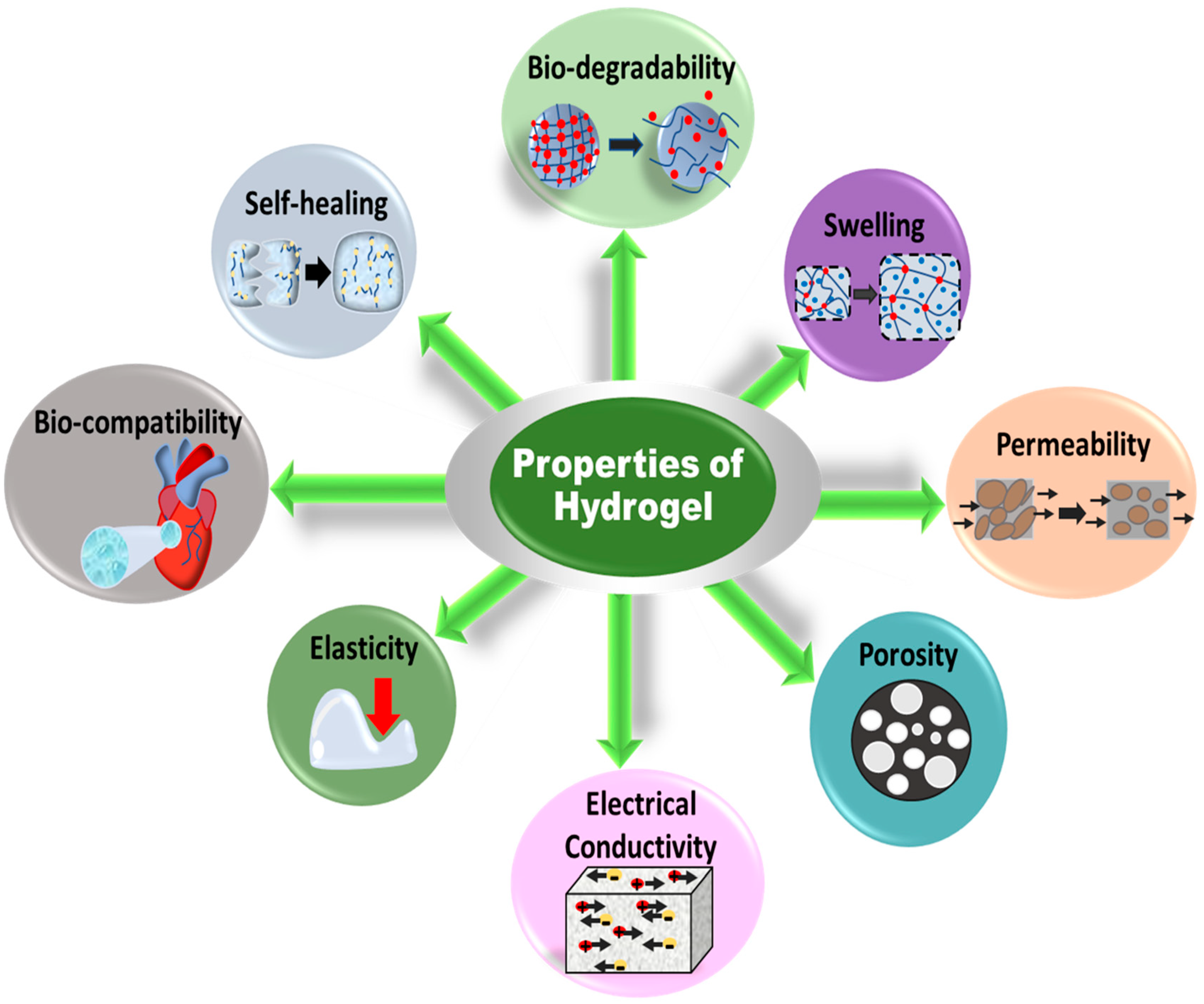
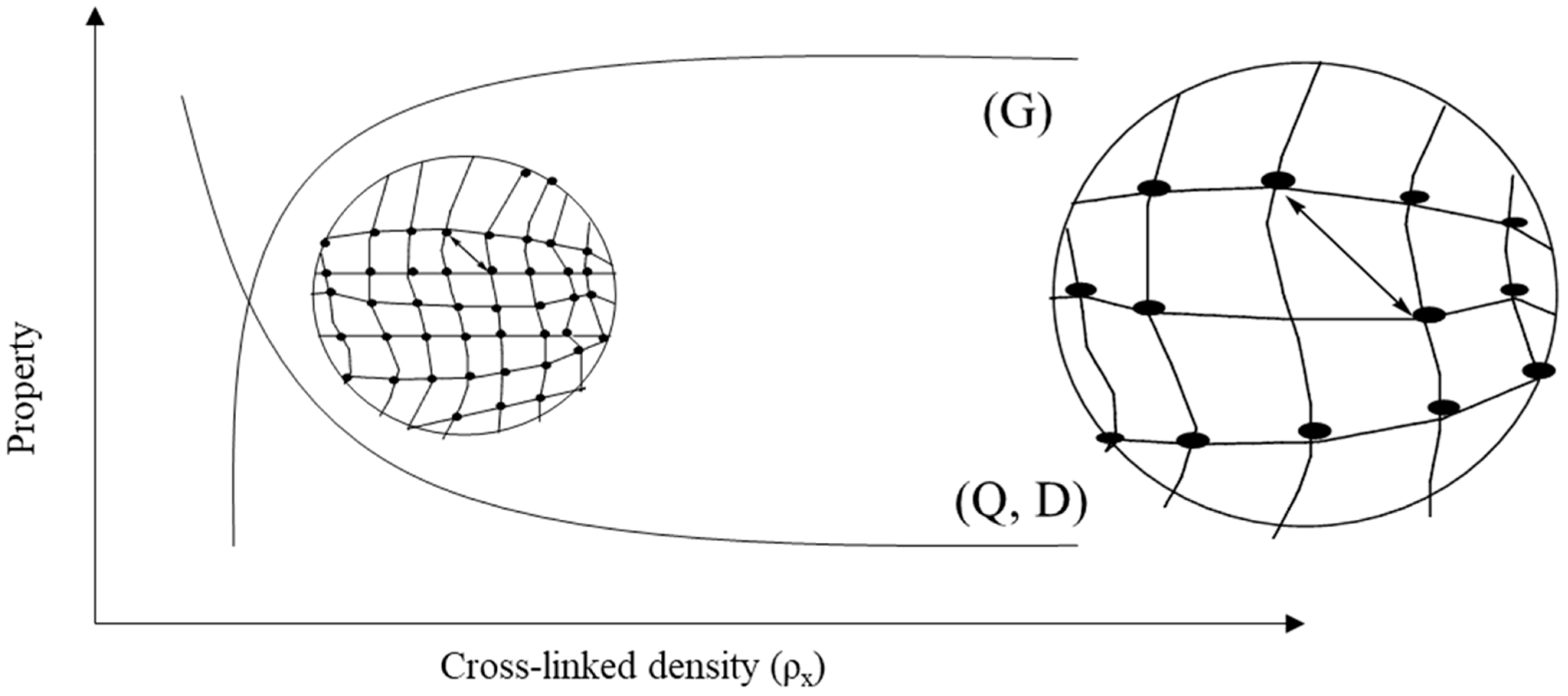
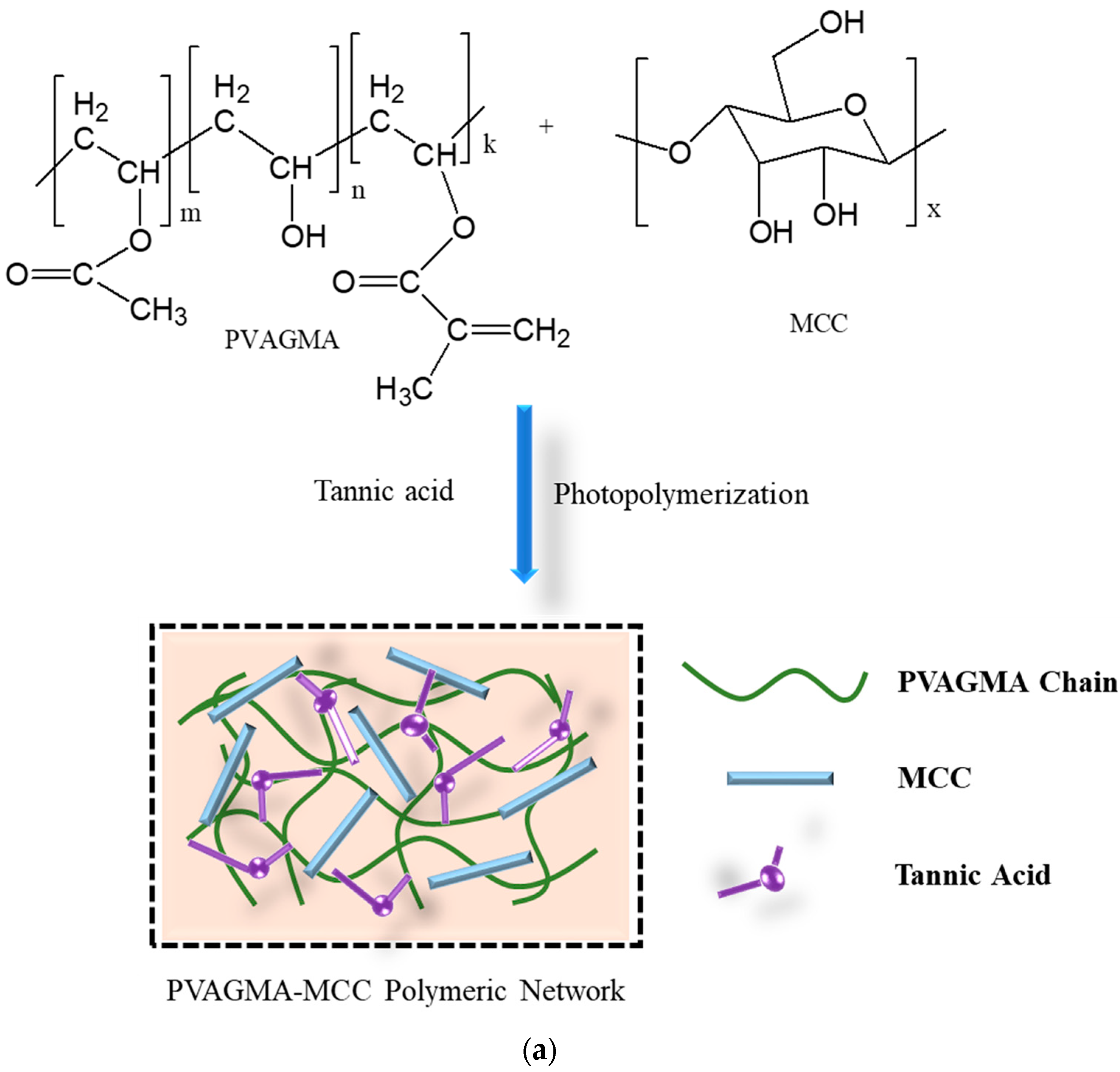
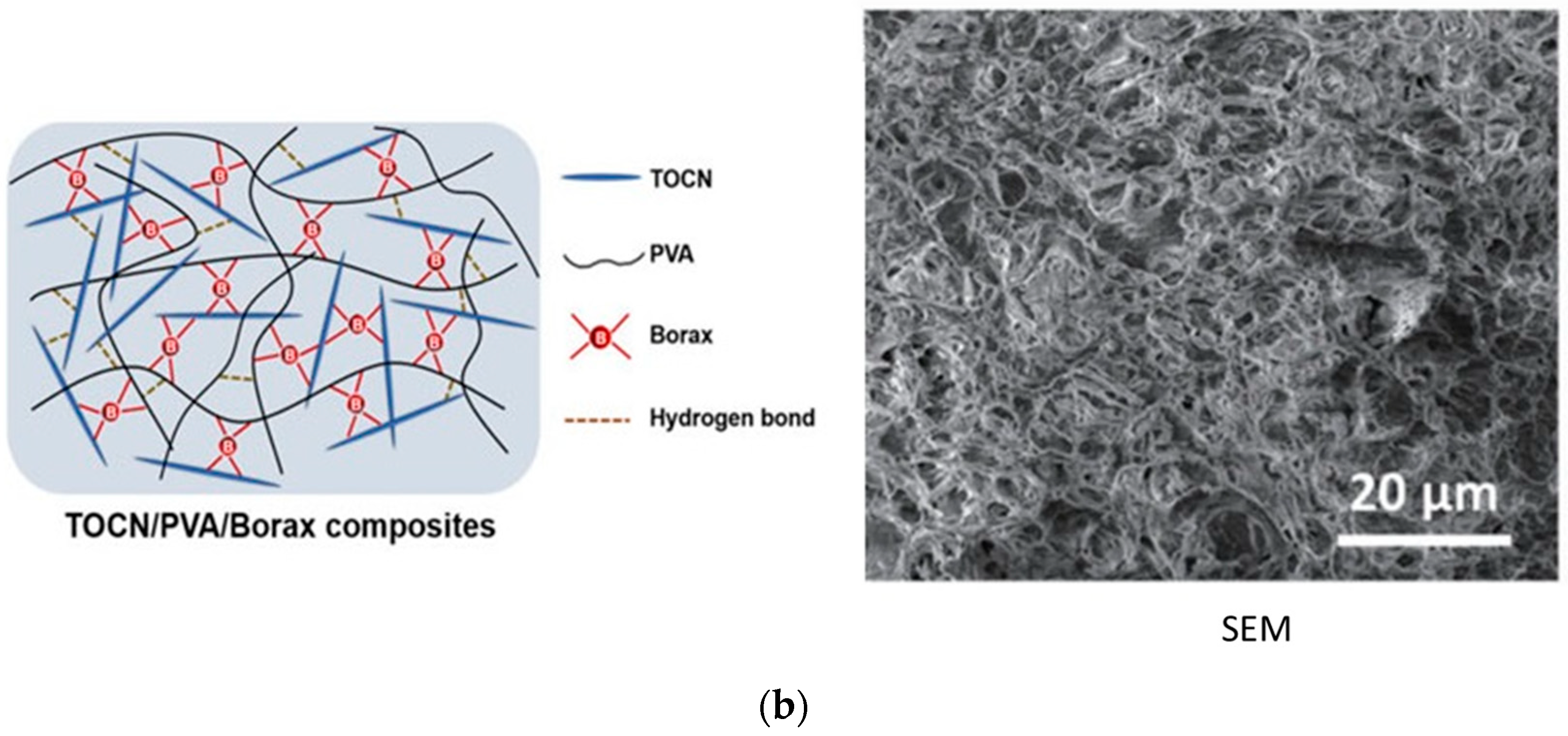
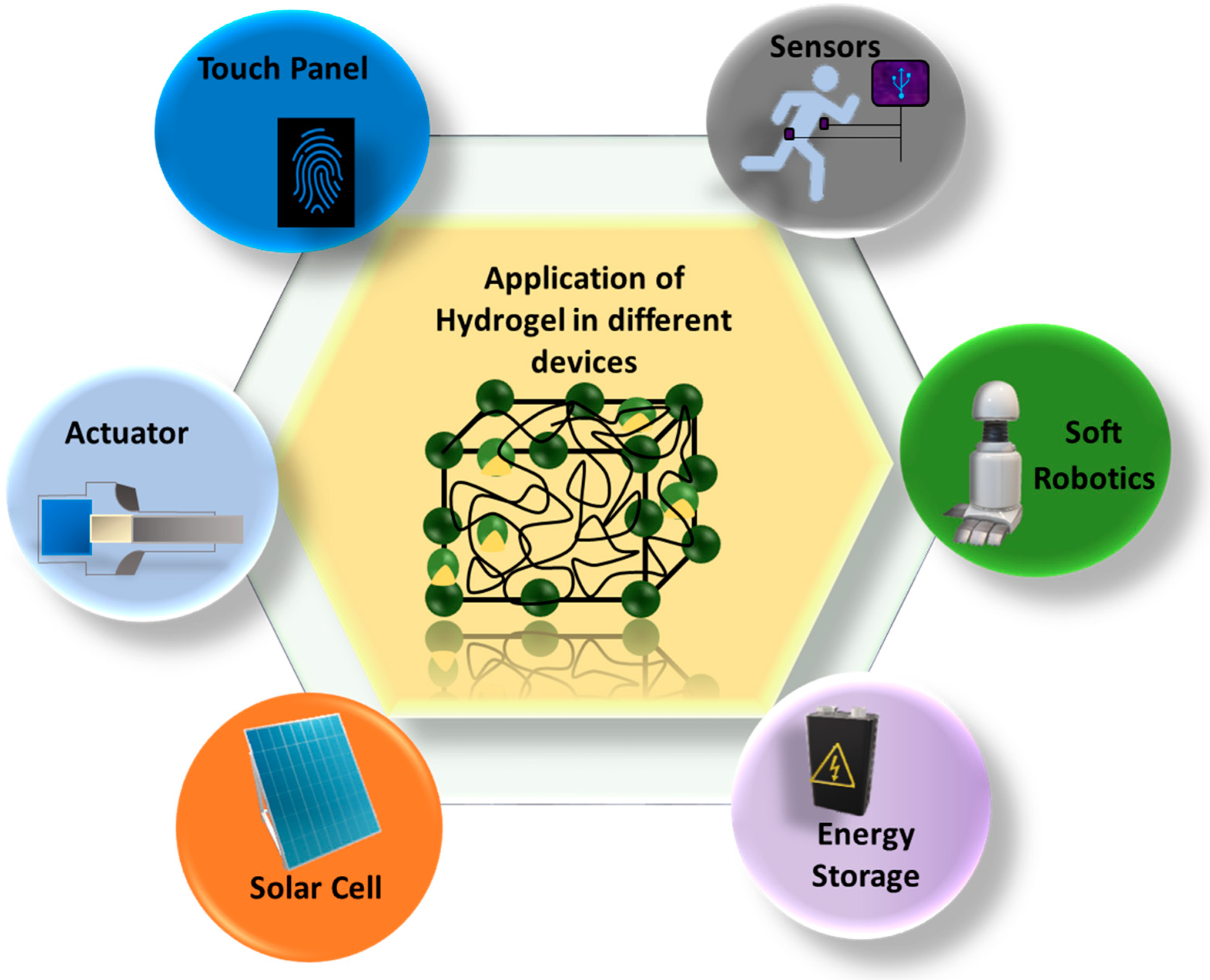
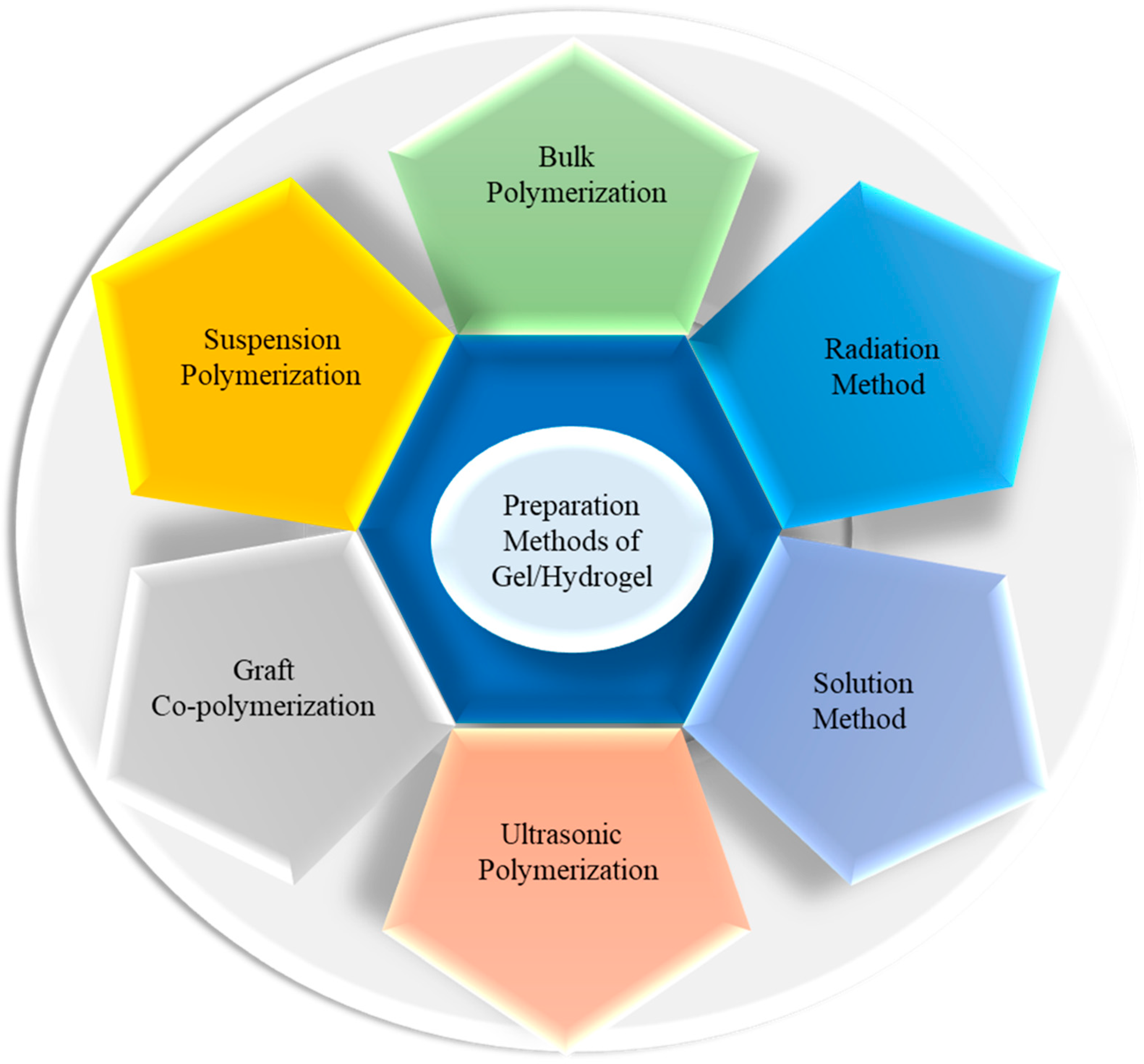
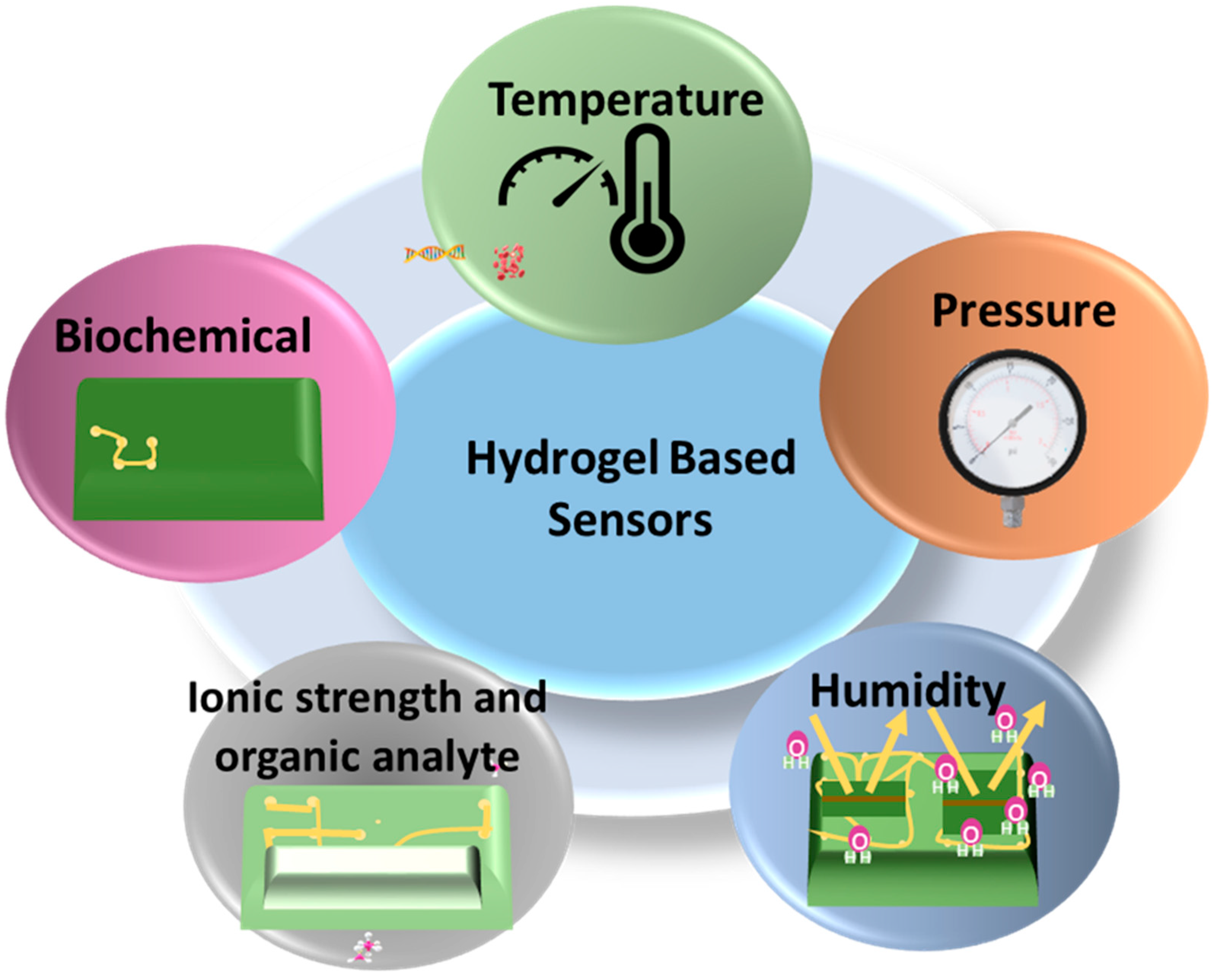

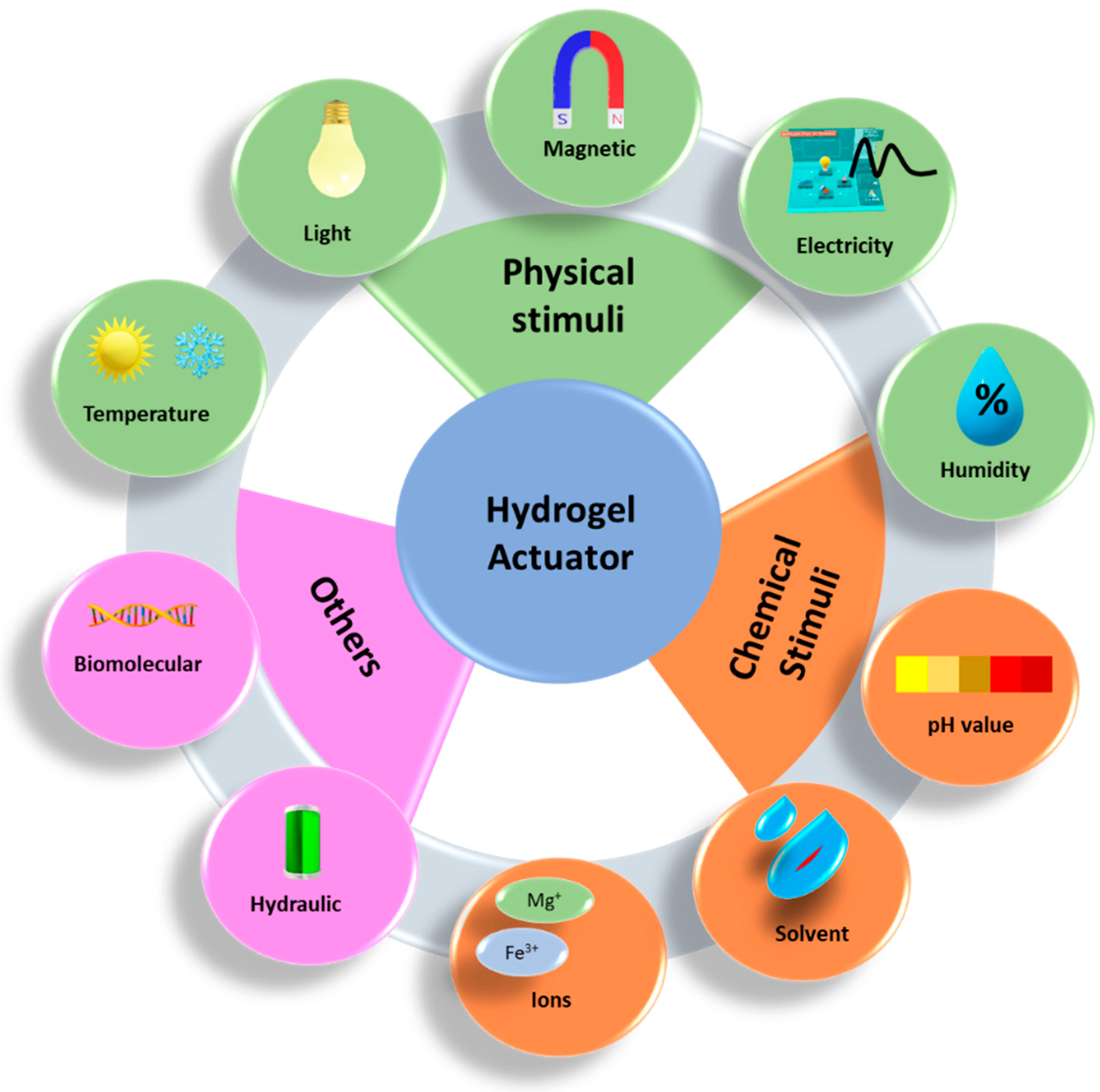



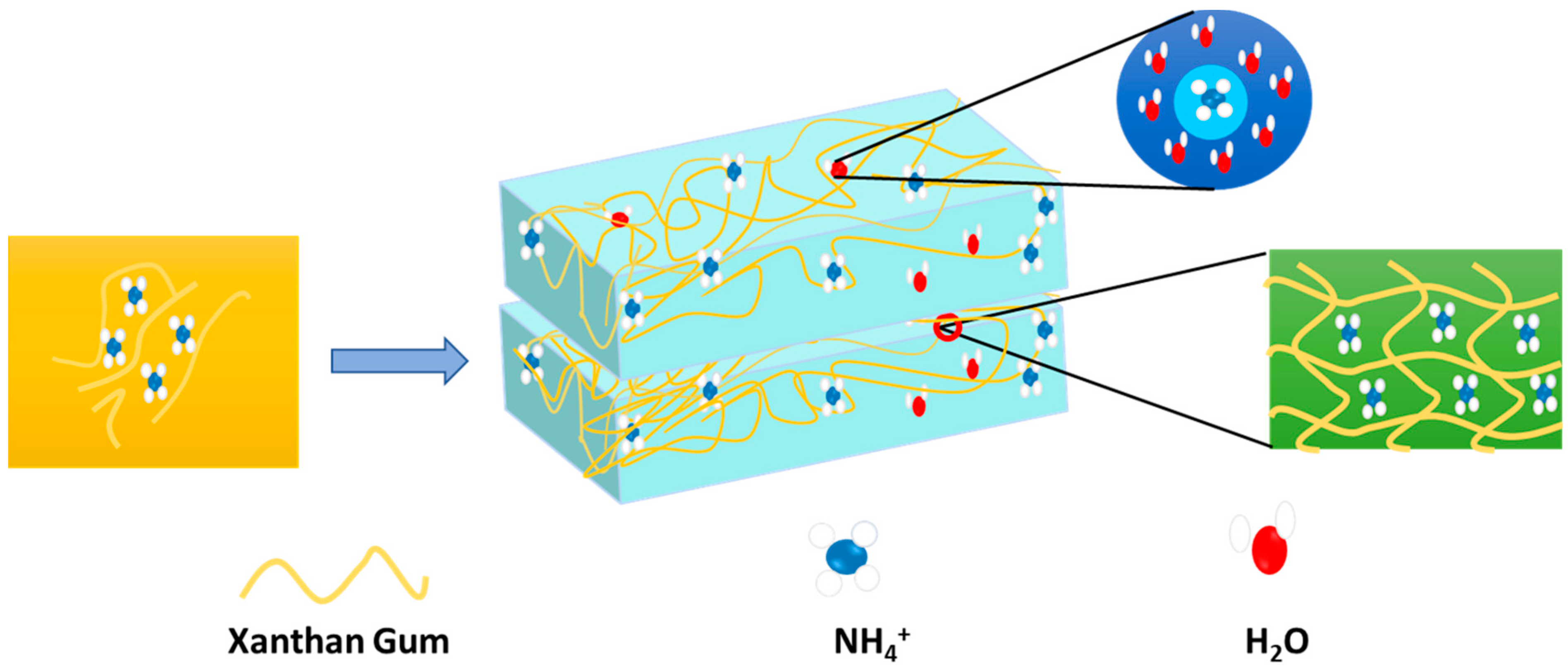

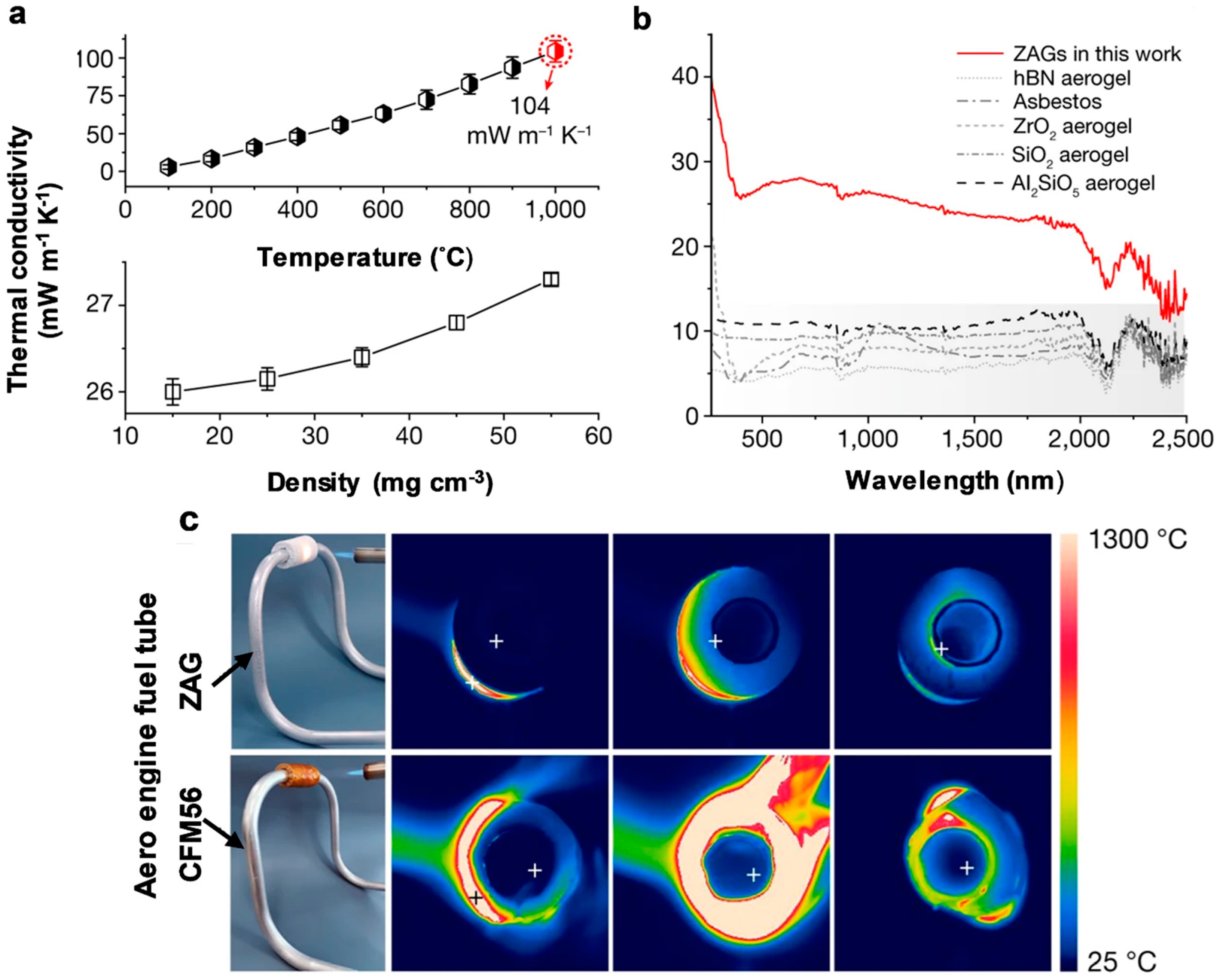
| S.N. | Name of Hydrogel | Characteristics | Types of Sensors and Applications | Performance | References |
|---|---|---|---|---|---|
| 01 | MXene poly(acrylic acid) (PAA)–amorphous calcium carbonate composite hydrogel | Excellent stretch ability, recyclability, favorable shape adaptability, adhesiveness | Pressure sensor. For e-skin. | 1. Conductivity 0.8 S m−1 2. Tensile strain >900% | [81] |
| 02 | Cationic cellulose nanofibers (CCNFs)–liquid metals (LM)–poly(acrylic acid) hydrogel | Good conductivity, mechanical property, self-adhesiveness, quick self-healing | Strain sensor. For monitoring human body movement. | 1. Conductivity 1.54 S m−1 2. Tensile strain >1500% | [82] |
| 03 | Poly(Vinyl alcohol) (PVA)–glutaraldehyde/poly(acrylic acid-co-Acrylamide) double network hydrogel | High adhesiveness, sensitivity, temp. tolerance | Stain and pressure sensor. For monitoring human motion and physiological activities. | 1. Conductivity 0.83 S m−1 2. Tensile strain 1700% | [83] |
| 04 | Chitosan-poly(Acrylamide-co-acrylic acid) double network hydrogel | Good mechanical properties, conductivity, durability, strong freezing tolerance | Strain and pressure sensor. For biomimetic, skin health monitoring, and soft robots. | 1. Conductivity 0.32 S m−1 2. Tensile Strain ~450% | [84] |
| 05 | Gelatin(G) carboxylated carbon(C) polypyrrole (PPy)–gold (AU) hydrogel | Good mechanical properties, electroconductivity, biocompatibility | Pressure sensor. For e-skin. | 1. Conductivity 2.33 S m−1 2. Tensile strain 253% | [85] |
| 06 | Poly(Vinyl alcohol) (PVA)/poly(Acrylamide-co-acrylic acid)-Fe3+ double network hydrogel | Maximum open-circuit voltage, short-circuit current, short-circuit transferred charge | Strain sensor. For wearable devices, human health monitoring, and energy harvesting. | 1. Toughness 6.5 MJ m−3 2. Elasticity modulus 0.4 MPa | [86] |
| 07 | Poly(Vinyl alcohol) (PVA)–cellulose nanofibers (CNF) hydrogel | Highly stretchable, strong, tough, transparent, and ionic conductive | Multi-functional strain and pressure sensor. For detecting human body movement. | 1. Toughness 5.25 MJ m−3 2. Elasticity modulus < 1.1 MPa | [87] |
| 08 | Double network hydrogel | Good biocompatibility, stretch ability, self-healing property | Strain sensor. For human and organ motion. | Self-healing efficiency 95.3% | [88] |
| 09 | Poly(Vinyl alcohol) (PVA)–borax(B)–sodium alginate (SA)–tannic acid (TA) hydrogel | pH sugar responsiveness, high stretch ability, high healing ability | Strain sensor. For detecting human motion. | Self-healing efficiency 93.56% in 10 min | [89] |
| 10 | Poly(Vinyl alcohol) (PVA)–MXene poly(3,4-ethylenedioxythiophene):poly(4-styrene sulfonate) hydrogel | Good biocompatibility | Multi-functional strain and position sensor. For human motion detection, detecting speed sensor, and hand-writing recognition. | Self-healing efficiency 95.47% in 30 min | [90] |
| 11 | Dried smart poly(N-isopropylacrylamide) hydrogel | Stable, porous structure, large surface area | Gas sensor | Exhibits a high affinity for various organic gases | [91] |
| S.N. | Name of Hydrogel | Characteristics | Types of Actuators and Applications | Performance | References |
|---|---|---|---|---|---|
| 01 | Poly(N-isopropylacrylamide)–clay nanocomposite (NS) hydrogel | Rapid, reversable, repeatable thermos-responsive bending | Thermo-responsive. Actuator for encapsulation, capture, and transportation. | Bending angle 180°/120 s | [105] |
| 02 | Poly(N-isopropylacrylamide)/poly(2-(dimethylamino)ethyl methacrylate)–acrylamide (AM) hydrogel | Temperature/salt- and temperature/pH-responsive | Bilayer and multiple stimuli-responsive. Actuator for soft robotics, biometric devices, and environmental sensors. | Bending angle 180°/60 s | [106] |
| 03 | Alginate-Poly(N-isopropylacrylamide)/Aluminum-alginate-Poly(N-isopropylacrylamide) hydrogel | High mechanical properties | Bilayer and thermo- responsive. Actuator for soft robotics. | Bending angle 140°/50 s | [107] |
| 04 | Poly(N-isopropylacrylamide)-poly(Vinyl alcohol)/poly(2-(dimethylamino)ethyl methacrylate)–poly(sodium-p-styrenesulfonate) hydrogel | Rapid, reversable, repeatable bending motion | Bilayer and intelligent responsive actuator. Soft actuator. | Bending angle 180°/60 s | [108] |
| 05 | Poly(N-isopropylacrylamide)/poly(Acrylic acid-co-acrylamide) hydrogel | Self-water circulation, reversible actuation | Bilayer and thermo-responsive. Actuator for soft material. | Bending angle 180°/60 s | [101] |
| 06 | Poly(N-isopropylacrylamide)/poly(3-(1-(4-vinylbenzyl)-1H-imidazol-3-ium-3-yl) propane-1-sulfonate) hydrogel | Fast, reversible, bidirectional bending behavior | Bilayer and thermo-responsive. Actuator for soft and intelligent material. | Bending angle 400 ° | [109] |
| 07 | Poly(Acrylic acid)/carboxylic reduced graphene oxide/Fe hydrogel | High stretch ability, self-healing ability, rapid bending actuation | Electro-responsive. Actuator for soft robots. | Bending angle > 150°/180 s | [110] |
| 08 | Carbon nanotube/poly((2-acrylamido-2-methyl-1-propane-sulfonic acid)-co-acrylic acid) hydrogel | Good electric conductivity | Electro-responsive. Strain actuator. | Bending angle 90°/120 s | [111] |
| 09 | Poly(N-isopropylacrylamide)-co-hydroxyethyl acrylate–laponite hydrogel | Fast response to hot water, rapid recovery in air | Thermo-responsive. Actuator for soft robots, micromanipulation, microfluidics, and artificial muscles. | Bending angle 100°/40 s | [112] |
| 10 | Poly(2-acrylamido-2-methyl-1-propane–sulfonic acid)/polypyrrole hydrogel | High elasticity, high bending rate | Electro-responsive. Actuator for electric field. | Time 40 s | [113] |
| S.N. | Name of the Hydrogel | Characteristics | Type of Touch Panel | Efficiency | Reference |
|---|---|---|---|---|---|
| 01 | Poly(N-isopropylacrylamide)–poly(vinyl alcohol)/sodium acrylate hydrogel | Stretchability, self-healing ability | Optical touch panel. For e-skin wearable electronics and smart windows. | Optical transparency 91%, stretch ability (150% to 600%) | [126] |
| 02 | Polyacrylamide hydrogel | Stretchability, biocompatibility | Capacitive touch panel. For e-skin. | Optical transparency 98%, stretch ability (>1000%) | [129] |
| 03 | Polyacrylic acid-polycation (poly(methyl chloride quaternized N < N-dimethyl-amino ethyl acrylate)) hydrogel | Self-healing ability, self-power voltage ability | Optical touch panel. For soft robotics and artificial intelligence. | Optical transparency 90%, stretch ability (>10,000%) | [130] |
| 04 | k-carrageenan/poly(N-acrloyl glycinamide (NAGA)–co-vinyl imidazole (VI)) hydrogel | Thermoplasticity, injectability, tough, fast self-recovery, thermal degradation resistance, durability, controllable adhesion | Resistive touch panel. For sensing devices. | Stretch ability (1045%) | [131] |
| 05 | Titanium dioxide/poly(N, N′-dimethylacrylamide) hydrogel | High stretch ability, soft, low parasite capacitance, high resolution, fast response | Capacitive touch panel. For e-skin. | Transparent stretch ability (1100%) | [115] |
| 06 | Silicon dioxide/lithium cation/poly(N, N′-dimethylacrylamide) hydrogel | Ultra-stretch ability, self-healing | Capacitive touch panel. For e-skin. | Stretch ability (>3800%) | [53] |
| 07 | Glycerin and hydroxyethyl cellulose elastomer and poly-acrylamide/carrageen hydrogel | Self-healing without degradation, good mechanical property, durability | Optical touch panel. For touch screen sensors. | Optical transparency 93%, stretch ability (310% for GHEC elastomer, 906% for PAM Carrageen) | [132] |
| 08 | Gelatin–poly acrylic acid (PAA)-based organic hydrogel | Excellent self-adhesion, self-healing, anti-freezing, anti-drying | Optical touch panel. For health care and human–machine interface. | Optical transparency 87%, stretch ability (1700% at 60 °C and 1200% at −20 °C) | [133] |
| 09 | Polyvinyl chloride ion gel | Good stretch ability, high transparency | Optical flexible touch panel. For smart electronic devices. | Optical transparency 90%, stretch ability (250%) | [134] |
| 10 | Poly(3,4-ethylenedioxythiophene):poly(styrene sulfonate) PEDOT:PSS ionogel | Mechanical and electrical conductivity and good transparency | Optical touch panel. For electronic and optoelectronic devices. | Optical transparency 87%, stretch ability (200%) | [135] |
| S.N. | Type of Gel | Characteristics | Type of Solar Cell | Photoelectric Conversion Efficiency | Reference |
|---|---|---|---|---|---|
| 01 | Poly(acrylic acid-co-acrylamide)/polyaniline hydrogel | Enhanced diffusion and reduction in iodine ions | Dye-sensitized solar cells | 2.0% | [141] |
| 02 | Graphene oxide/gelatin hydrogel | High open-circuit voltage | Quasi-solid-state dye-sensitized solar cells | 4.02% | [142] |
| 03 | Polyacrylamide/bis-acrylamide hydrogel | High absorbent ability | Quasi-solid-state quantum-dot-sensitized solar cell | 4.3% | [143] |
| 04 | Polyvinyl alcohol/multiwall carbon nanotube/polyaniline hydrogel | Good ionic conductivity charge transportation | Dye-sensitized solar cells | 2.18% | [144] |
| 05 | Polysaccharide dextran hydrogel | Good light intensity | Quasi-solid-state quantum dot-sensitized solar cells | 4.58% | [18] |
| 06 | Polysulfide hydrogel | Long-term stability | Quasi-solid-state quantum-dot-sensitized solar cells | 2.40% | [145] |
| 07 | Graphene hydrogel | Good stability | Quantum-dot-sensitized solar cells | 10.71% | [146] |
| 08 | Carbon nanotube/graphene hydrogel/copper sulfide | Good conductivity, catalytic activity | Quantum-dot-sensitized solar cells | 14.02% | [147] |
| 09 | Chlorophyll–a/polyacrylamide hydrogel | High pigment absorption | Biomimetic solar cells | Power conversion efficiency is 0.59%. | [148] |
| 10 | Poly(m-amino benzodioxol)–iron (ii, iii) oxide nanorods hydrogel | High thermal stability and photovoltaic properties | Hybrid solar cell | 6.08% | [149] |
| S.N. | Name of Hydrogel | Characteristics | Type of Battery | Performance | References |
|---|---|---|---|---|---|
| 01 | Carboxymethyl cellulose (CMC) hydrogel | Low cost, high cycling ability | Zn-ion batteries | 1. Conductivity 34.5 mS cm−1 2. Mechanical strength 1.33 MPa | [159] |
| 02 | Chitosan–Zn membrane electrolyte | High conductivity, non-flammability | Zn-metal batteries | 1. Conductivity 71.8 mS cm−1 2. Mechanical strength 7.4 MPa | [160] |
| 03 | Kappa (k)-carrageenan–chitosan hydrogel | High cycling stability, mechanical strength | Zn-metal batteries | 1. Conductivity 5.3 mS cm−1 2. Mechanical strength 14.2 MPa | [161] |
| 04 | Natural chitosan–glass fiber hydrogel | High conductivity | Zn-ion batteries | 1. Conductivity 83.4 mS cm−1 2. Mechanical strength 2.40 MPa | [162] |
| 05 | Gelatin-based hydrogel electrolyte | High conductivity, easy fabrication | Zn-metal batteries | 1. Conductivity 37.2 mS cm−1 2. Mechanical strength −100 MPa | [163] |
| 06 | Xanthan gum hydrogel | High conductivity, easy fabrication | Zn-ion batteries | 1. Conductivity 14.6 mS cm−1 | [164] |
| 07 | Cellulose nanofiber–polyacrylamide (PAM) hydrogel electrolyte | High cycling stability, wide temperature stable window | Zn-ion batteries | 1. Conductivity 6.8 mS cm−1 2. Mechanical strength 192 MPa | [165] |
| 08 | Polyacrylamide (PAM)–cotton cellulose nanofiber–carboxymethyl cellulose (CMC) hydrogel | Very high conductivity, high stretchability | Zn-ion batteries | 1. Conductivity 2.492 S m−1 2. Mechanical strength 60 MPa | [166] |
| 09 | Xanthan gum g-cellulose nanofiber/cotton cellulose nanofiber hydrogel | High mechanical strength and good adhesion | Zn-ion batteries | Ionic conductivity 28.8 mS cm−1, tensile strength of 84 kPa | [167] |
| 10 | Poly(2-acrylamido-2-methyl propane sulfonic acid potassium salt)/methyl cellulose hydrogel | Rapid self-recovery, good toughness, and antifatigue properties | Zn–air batteries | Ionic conductivity 105 mS cm−1, compressive strength of 170 kPa | [168] |
| S.N. | Name of Hydrogel | Characteristics | Type of Robotics | Performance | References |
|---|---|---|---|---|---|
| 01 | Poly(N-isopropylacrylamide)/graphene oxide hydrogel | Fast bending actuation | Soft robotics | 1. Response time 16–24 s 2. Tensile strength 83 kPa 3. Bending motion | [170] |
| 02 | Poly(N-isopropylacrylamide)/poly(acrylic acid-co-acrylamide) hydrogel | Reversible actuation | Soft robotics | 1. Response time ~60 s 2. Bending motion | [101] |
| 03 | Chitosan/carboxymethyl cellulose hydrogel | Rapid, reversible, bidirectional deformation | Soft robotics | 1. Response time 240 s 2. Tensile strength 62 kPa 3. Coiling motion | [171] |
| 04 | Poly(N-isopropylacrylamide)/graphene oxide hydrogel | Excellent comprehensive actuation | Soft robotics | 1. Response time 40 s 2. Bending motion | [172] |
| 05 | Poly(N-isopropylacrylamide-co-Ru(bpy)32+)-ruthenium(ii) tris(2,2-bipyridine)-co-hydrophilic 2-acrylamide-2 methylpropane sulfonic acid hydrogel | Repeated bending and stretching motion | Biometric robotics | 1. Tensile strength 410 kPa | [173] |
| 06 | Poly(N-isopropylacrylamide)/2-acrylamido-2-methylpropane sulphonic acid hydrogel | Different shrinkage and elastic moduli on applied external stimuli | Programmable soft robotics | 1. Response time 2 h 2. Twisting motion | [174] |
| 07 | Polyethylene glycol diacrylate/gelatin methacrylate-co-Polyethylene glycol dimethacrylate hydrogel | Shape-change ability | Soft robotics | 1. Tensile strength 20.3/1.8 kPa 2. Folding and twisting motion | [175] |
| 08 | Poly(N-isopropylacrylamide)/polyethylene glycol diacrylate hydrogel | Untethered, self-folding | Micro transport robotics | 1. Response time 60–120 s 2. Bending and rotating motion | [176] |
| 09 | Graphene oxide–polydimethylsiloxane/polydimethylsiloxane hydrogel | Excellent stability | Soft robotics | 1. Response time 1–5 s 2. Swimming motion | [177] |
| 10 | Graphene oxide/graphene oxide–polydopamine hydrogel | Light sensitivity | Soft robotics | 1. Response time 1.5 s 2. Crawl motion | [178] |
Disclaimer/Publisher’s Note: The statements, opinions and data contained in all publications are solely those of the individual author(s) and contributor(s) and not of MDPI and/or the editor(s). MDPI and/or the editor(s) disclaim responsibility for any injury to people or property resulting from any ideas, methods, instructions or products referred to in the content. |
© 2024 by the authors. Licensee MDPI, Basel, Switzerland. This article is an open access article distributed under the terms and conditions of the Creative Commons Attribution (CC BY) license (https://creativecommons.org/licenses/by/4.0/).
Share and Cite
Bhuyan, M.M.; Jeong, J.-H. Gels/Hydrogels in Different Devices/Instruments—A Review. Gels 2024, 10, 548. https://doi.org/10.3390/gels10090548
Bhuyan MM, Jeong J-H. Gels/Hydrogels in Different Devices/Instruments—A Review. Gels. 2024; 10(9):548. https://doi.org/10.3390/gels10090548
Chicago/Turabian StyleBhuyan, Md Murshed, and Jae-Ho Jeong. 2024. "Gels/Hydrogels in Different Devices/Instruments—A Review" Gels 10, no. 9: 548. https://doi.org/10.3390/gels10090548
APA StyleBhuyan, M. M., & Jeong, J.-H. (2024). Gels/Hydrogels in Different Devices/Instruments—A Review. Gels, 10(9), 548. https://doi.org/10.3390/gels10090548








